Guide to Understanding Sail Rig Types (with Pictures)
There are a lot of different sail rig types and it can be difficult to remember what's what. So I've come up with a system. Let me explain it in this article.
What are the different types of sail rig? The sail rig is determined by the number of masts and the layout and shape of sails. Most modern ships are fore-and-aft rigged, while old ships are square-rigged. Rigs with one mast are sloops and cutters. Ketches, yawls, brigs, and schooners have two masts. Barques have three masts. Rigs can contain up to seven masts.
'Yeah, that's a gaff brig, and that a Bermuda cutter' - If you don't know what this means (neither did I) and want to know what to call a two-masted ship with a square-rigged mainsail, this article is definitely for you.


On this page:
More info on sail rig types, mast configurations and rig types, rigs with one mast, rigs with two masts, rigs with three masts, related questions.
This article is part 2 of my series on sails and rig types. Part 1 is all about the different types of sails. If you want to know everything there is to know about sails once and for all, I really recommend you read it. It gives a good overview of sail types and is easy to understand.
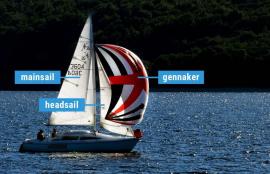
The Ultimate Guide to Sail Types and Rigs (with Pictures)
First of all, what is a sail rig? A sail rig is the way in which the sails are attached to the mast(s). In other words, it's the setup or configuration of the sailboat. The rig consists of the sail and mast hardware. The sail rig and sail type are both part of the sail plan. We usually use the sail rig type to refer to the type of boat.
Let's start by taking a look at the most commonly used modern sail rigs. Don't worry if you don't exactly understand what's going on. At the end of this article, you'll understand everything about rig types.
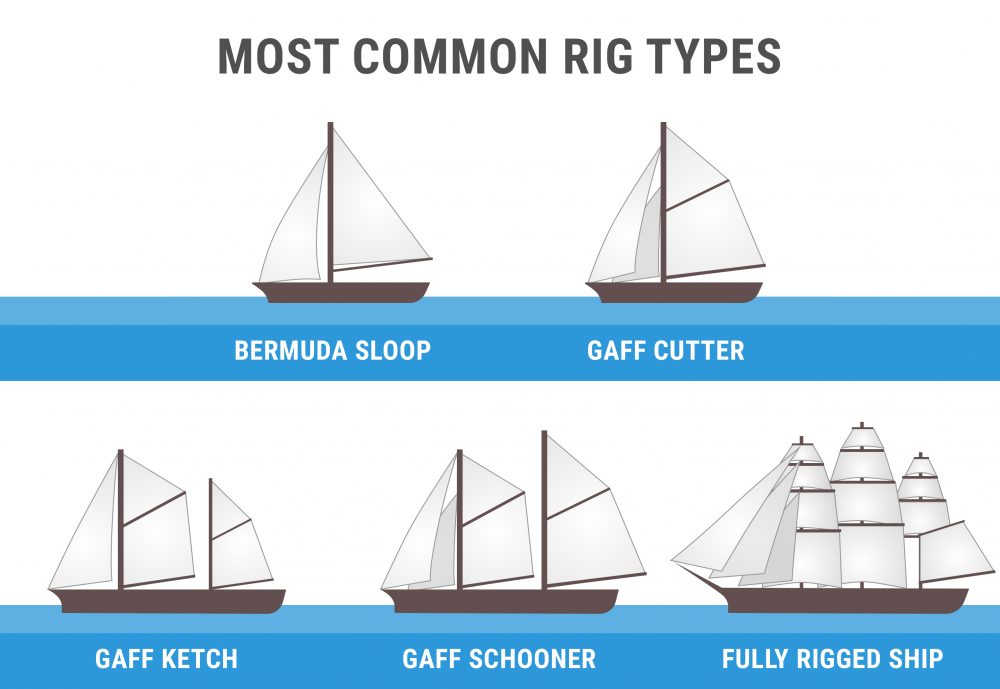
The sail rig and sail plan are often used interchangeably. When we talk of the sail rig we usually mean the sail plan . Although they are not quite the same. A sail plan is the set of drawings by the naval architect that shows the different combinations of sails and how they are set up for different weather conditions. For example a light air sail plan, storm sail plan, and the working sail plan (which is used most of the time).
So let's take a look at the three things that make up the sail plan.
The 3 things that make up the sail plan
I want to do a quick recap of my previous article. A sail plan is made up of:
- Mast configuration - refers to the number of masts and where they are placed
- Sail type - refers to the sail shape and functionality
- Rig type - refers to the way these sails are set up on your boat
I'll explore the most common rig types in detail later in this post. I've also added pictures to learn to recognize them more easily. ( Click here to skip to the section with pictures ).
How to recognize the sail plan?
So how do you know what kind of boat you're dealing with? If you want to determine what the rig type of a boat is, you need to look at these three things:
- Check the number of masts, and how they are set up.
- You look at the type of sails used (the shape of the sails, how many there are, and what functionality they have).
- And you have to determine the rig type, which means the way the sails are set up.
Below I'll explain each of these factors in more detail.
The most common rig types on sailboats
To give you an idea of the most-used sail rigs, I'll quickly summarize some sail plans below and mention the three things that make up their sail plan.
- Bermuda sloop - one mast, one mainsail, one headsail, fore-and-aft rigged
- Gaff cutter - one mast, one mainsail, two staysails, fore-and-aft rigged
- Gaff schooner - two-masted (foremast), two mainsails, staysails, fore-and-aft rigged
- Gaff ketch - two-masted (mizzen), two mainsails, staysails, fore-and-aft rigged
- Full-rigged ship or tall ship - three or more masts, mainsail on each mast, staysails, square-rigged
The first word is the shape and rigging of the mainsail. So this is the way the sail is attached to the mast. I'll go into this later on. The second word refers to the mast setup and amount of sails used.
Most sailboats are Bermuda sloops. Gaff-rigged sails are mostly found on older, classic boats. Square-rigged sails are generally not used anymore.
But first I want to discuss the three factors that make up the sail plan in more detail.
Ways to rig sails
There are basically two ways to rig sails:
- From side to side, called Square-rigged sails - the classic pirate sails
- From front to back, called Fore-and-aft rigged sails - the modern sail rig
Almost all boats are fore-and-aft rigged nowadays.
Square sails are good for running downwind, but they're pretty useless when you're on an upwind tack. These sails were used on Viking longships, for example. Their boats were quicker downwind than the boats with fore-and-aft rigged sails, but they didn't handle as well.
The Arabs first used fore-and-aft rigged sails, making them quicker in difficult wind conditions.
Quick recap from part 1: the reason most boats are fore-and-aft rigged today is the increased maneuverability of this configuration. A square-rigged ship is only good for downwind runs, but a fore-and-aft rigged ship can sail close to the wind, using the lift to move forward.
The way the sails are attached to the mast determines the shape of the sail. The square-rigged sails are always attached the same way to the mast. The fore-and-aft rig, however, has a lot of variations.
The three main sail rigs are:
- Bermuda rig - most used - has a three-sided (triangular) mainsail
- Gaff rig - has a four-sided mainsail, the head of the mainsail is guided by a gaff
- Lateen rig - has a three-sided (triangular) mainsail on a long yard
The Bermuda is the most used, the gaff is a bit old-fashioned, and the lateen rig is outdated (about a thousand years). Lateen rigs were used by the Moors. The Bermuda rig is actually based on the Lateen rig (the Dutch got inspired by the Moors).

Other rig types that are not very common anymore are:
- Junk rig - has horizontal battens to control the sail
- Settee rig - Lateen with the front corner cut off
- Crabclaw rig
Mast configuration
Okay, we know the shape of the mainsail. Now it's time to take a look at the mast configuration. The first thing is the number of masts:
- one-masted boats
- two-masted boats
- three-masted boats
- four masts or up
- full or ship-rigged boats - also called 'ships' or 'tall ships'
I've briefly mentioned the one and two mast configurations in part 1 of this article. In this part, I'll also go over the three-masted configurations, and the tall ships as well.
A boat with one mast has a straightforward configuration because there's just one mast. You can choose to carry more sails or less, but that's about it.
A boat with two masts or more gets interesting. When you add a mast, it means you have to decide where to put the extra mast: in front, or in back of the mainmast. You can also choose whether or not the extra mast will carry an extra mainsail. The placement and size of the extra mast are important in determining what kind of boat we're dealing with. So you start by locating the largest mast, which is always the mainmast.
From front to back: the first mast is called the foremast. The middle mast is called the mainmast. And the rear mast is called the mizzenmast.

What is the mizzenmast? The mizzenmast is the aft-most (rear) mast on a sailboat with three or more masts or the mast behind the mainmast on a boat with two masts. The mizzenmast carries the mizzen sail. On a two-masted boat, the mizzenmast is always (slightly) smaller than the mainmast. What is the purpose of the mizzen sail? The mizzen sail provides more sail area and flexibility in sail plan. It can be used as a big wind rudder, helping the sailor to have more control over the stern of the ship. It pushes the stern away from the wind and forces the bow in the opposite way. This may help to bring the bow into the wind when at anchor.
I always look at the number of masts first, because this is the easiest to spot. So to make this stuff more easy to understand, I've divided up the rig types based on the number of masts below.
Why would you want more masts and sail anyways?
Good question. The biggest advantage of two masts compared to one (let's say a ketch compared to a sloop), is that it allows you to use multiple smaller sails to get the same sail area. It also allows for shorter masts.
This means you reduce the stress on the rigging and the masts, which makes the ketch rig safer and less prone to wear and tear. It also doesn't capsize as quickly. So there are a couple of real advantages of a ketch rig over a sloop rig.
In the case of one mast, we look at the number of sails it carries.
Boats with one mast can have either one sail, two sails, or three or more sails.
Most single-masted boats are sloops, which means one mast with two sails (mainsail + headsail). The extra sail increases maneuverability. The mainsail gives you control over the stern, while the headsail gives you control over the bow.
Sailor tip: you steer a boat using its sails, not using its rudder.
The one-masted rigs are:
- Cat - one mast, one sail
- Sloop - one mast, two sails
- Cutter - one mast, three or more sails
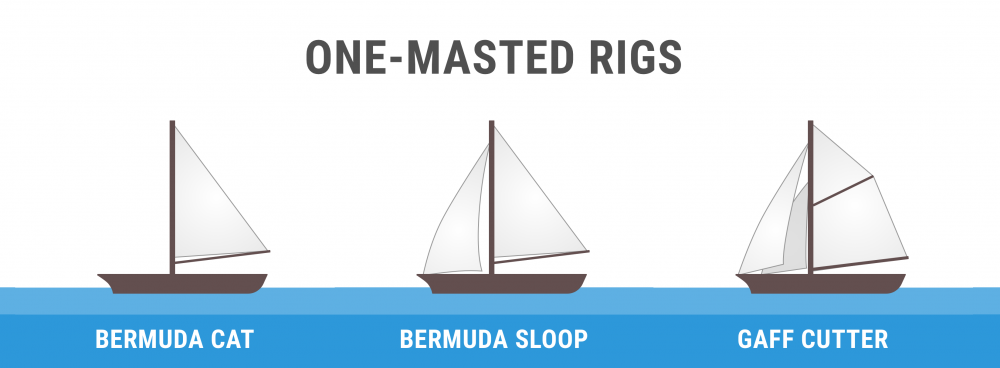
The cat is the simplest sail plan and has one mast with one sail. It's easy to handle alone, so it's very popular as a fishing boat. Most (very) small sailboats are catboats, like the Sunfish, and many Laser varieties. But it has a limited sail area and doesn't give you the control and options you have with more sails.
The most common sail plan is the sloop. It has one mast and two sails: the main and headsail. Most sloops have a Bermuda mainsail. It's one of the best racing rigs because it's able to sail very close to the wind (also called 'weatherly'). It's one of the fastest rig types for upwind sailing.
It's a simple sail plan that allows for high performance, and you can sail it short-handed. That's why most sailboats you see today are (Bermuda) sloops.
This rig is also called the Marconi rig, and it was developed by a Dutch Bermudian (or a Bermudian Dutchman) - someone from Holland who lived on Bermuda.
A cutter has three or more sails. Usually, the sail plan looks a lot like the sloop, but it has three headsails instead of one. Naval cutters can carry up to 6 sails.
Cutters have larger sail area, so they are better in light air. The partition of the sail area into more smaller sails give you more control in heavier winds as well. Cutters are considered better for bluewater sailing than sloops (although sloops will do fine also). But the additional sails just give you a bit more to play with.
Two-masted boats can have an extra mast in front or behind the mainmast. If the extra mast is behind (aft of) the mainmast, it's called a mizzenmast . If it's in front of the mainmast, it's called a foremast .
If you look at a boat with two masts and it has a foremast, it's most likely either a schooner or a brig. It's easy to recognize a foremast: the foremast is smaller than the aft mast.
If the aft mast is smaller than the front mast, it is a sail plan with a mizzenmast. That means the extra mast has been placed at the back of the boat. In this case, the front mast isn't the foremast, but the mainmast. Boats with two masts that have a mizzenmast are most likely a yawl or ketch.
The two-masted rigs are:
- Lugger - two masts (mizzen), with lugsail (a cross between gaff rig and lateen rig) on both masts
- Yawl - two masts (mizzen), fore-and-aft rigged on both masts. Main mast is much taller than mizzen. Mizzen without a mainsail.
- Ketch - two masts (mizzen), fore-and-aft rigged on both masts. Main mast with only slightly smaller mizzen. Mizzen has mainsail.
- Schooner - two masts (foremast), generally gaff rig on both masts. Main mast with only slightly smaller foremast. Sometimes build with three masts, up to seven in the age of sail.
- Bilander - two masts (foremast). Has a lateen-rigged mainsail and square-rigged sails on the foremast and topsails.
- Brig - two masts (foremast), partially square-rigged. The main mast carries small lateen-rigged sail.

The yawl has two masts that are fore-and-aft rigged and a mizzenmast. The mizzenmast is much shorter than the mainmast, and it doesn't carry a mainsail. The mizzenmast is located aft of the rudder and is mainly used to increase helm balance.
A ketch has two masts that are fore-and-aft rigged. The extra mast is a mizzenmast. It's nearly as tall as the mainmast and carries a mainsail. Usually, the mainsails of the ketch are gaff-rigged, but there are Bermuda-rigged ketches too. The mizzenmast is located in front of the rudder instead of aft, as on the yawl.
The function of the ketch's mizzen sail is different from that of the yawl. It's actually used to drive the boat forward, and the mizzen sail, together with the headsail, are sufficient to sail the ketch. The mizzen sail on a yawl can't really drive the boat forward.
Schooners have two masts that are fore-and-aft rigged. The extra mast is a foremast which is generally smaller than the mainmast, but it does carry a mainsail. Schooners are also built with a lot more masts, up to seven (not anymore). The schooner's mainsails are generally gaff-rigged.
The schooner is easy to sail but not very fast. It handles easier than a sloop, except for upwind, and it's only because of better technology that sloops are now more popular than the schooner.
The brig has two masts. The foremast is always square-rigged. The mainmast can be square-rigged or is partially square-rigged. Some brigs carry a lateen mainsail on the mainmast, with square-rigged topsails.
Some variations on the brig are:
Brigantine - two masts (foremast), partially square-rigged. Mainmast carries no square-rigged mainsail.
Hermaphrodite brig - also called half brig or schooner brig. Has two masts (foremast), partially square-rigged. Mainmast carries a gaff rig mainsail and topsail, making it half schooner.
Three-masted boats are mostly barques or schooners. Sometimes sail plans with two masts are used with more masts.
The three-masted rigs are:
- Barque - three masts, fore, and mainmast are square-rigged, the mizzenmast is usually gaff-rigged. All masts carry mainsail.
- Barquentine - three masts, foremast is square-rigged, the main and mizzenmast are fore-and-aft rigged. Also called the schooner barque.
- Polacca - three masts, foremast is square-rigged, the main and mizzenmast are lateen-rigged.
- Xebec - three masts, all masts are lateen-rigged.

A barque has three or four masts. The fore and mainmast are square-rigged, and the mizzen fore-and-aft, usually gaff-rigged. Carries a mainsail on each mast, but the mainsail shape differs per mast (square or gaff). Barques were built with up to five masts. Four-masted barques were quite common.
Barques were a good alternative to full-rigged ships because they require a lot fewer sailors. But they were also slower. Very popular rig for ocean crossings, so a great rig for merchants who travel long distances and don't want 30 - 50 sailors to run their ship.
Barquentine
The barquentine usually has three masts. The foremast is square-rigged and the main and mizzenmast fore-and-aft. The rear masts are usually gaff-rigged.
Faster than a barque or a schooner, but the performance is worse than both.
The polacca or polacre rig has three masts with a square-rigged foremast. The main and mizzenmast are lateen-rigged. Beautiful boat to see. Polacca literally means 'Polish' (it's Italian). It was a popular rig type in the Mediterranean in the 17th century. It looks like the xebec, which has three lateen-rigged masts.
Fun fact: polaccas were used by a Dutch sailor-turned-Turkish-pirate (called Murat Reis).
The xebec is a Mediterranean trading ship with three masts. All masts are lateen-rigged. I couldn't find any surviving xebecs, only models and paintings. So I guess this rig is outdated a long time.
A boat with three or more masts that all carry square-rigged sails is called a ship, a tall ship, or a full-rigged ship. So it's at this point that we start calling boats 'ships'. It has nothing to do with size but with the type of rigging.
More sails mean less stress on all of them. These ships use a lot of sails to distribute the forces, which reduces the stress on the rigging and the masts. Square sails mean double the sail area in comparison to triangular sails.
They are quite fast for their size, and they could outrun most sloops and schooners (schooners were relatively a lot heavier). The reason is that tall ships could be a lot longer than sloops, giving them a lot of extra hull speed. Sloops couldn't be as large because there weren't strong enough materials available. Try making a single triangular sail with a sail area of over 500 sq. ft. from linen.
So a lot of smaller sails made sense. You could have a large ship with a good maximum hull speed, without your sails ripping apart with every gust of wind.
But you need A LOT of sailors to sail a tall ship: about 30 sailors in total to ie. reef down sails and operate the ship. That's really a lot.
Tall ships are used nowadays for racing, with the popular tall ship races traveling the world. Every four years I go and check them out when they are at Harlingen (which is very close to where I live).
Check out the amazing ships in this video of the tall ship races last year near my hometown. (The event was organized by friends of mine).
What is the difference between a schooner and a sloop? A schooner has two masts, whereas the sloop only has one. The schooner carries more sails, with a mainsail on both masts. Also, sloops are usually Bermuda-rigged, whereas schooners are usually gaff-rigged. Most schooners also carry one or two additional headsails, in contrast to the single jib of the sloop.
What do you call a two-masted sailboat? A two-masted sailboat is most likely a yawl, ketch, schooner, or brig. To determine which one it is you have to locate the mainmast (the tallest). At the rear: schooner or brig. In front: yawl or ketch. Brigs have a square-rigged foremast, schooners don't. Ketches carry a mainsail on the rear mast; yawls don't.
What is a sloop rig? A sloop rig is a sailboat with one mast and two sails: a mainsail and headsail. It's a simple sail plan that handles well and offers good upwind performance. The sloop rig can be sailed shorthanded and is able to sail very close to the wind, making it very popular. Most recreational sailboats use a sloop rig.
What is the difference between a ketch and a yawl? The most important difference between a ketch and a yawl are the position and height of the mizzenmast. The mizzenmast on a yawl is located aft of the rudder, is shorter than the mainmast and doesn't carry a mainsail. On a ketch, it's nearly as long as the mainmast and carries a mainsail.

There are a wonderful lots of DIY changeability shows on the cable airwaves these days.
Rick the rigger
There are SO many errors on this site it really should be taken down.
First major mistake is to say you are no longer afraid of the sea.
One that truly gets up my nose is the term ‘fully’ rigged ship. It’s a FULL rigged ship!! Your mast names are the wrong way round and just because there may be 3 it doesn’t automatically mean the one in the middle is the main.
I could go on and totally destroy your over inflated but fragile ego but I won’t. All I will say is go learn a lot more before posting.
Shawn Buckles
Thanks for your feedback. If you like to point out anything more specific, please let me know and I will update the articles. I’ve changed fully-rigged to full-rigged ship - which is a typo on my part. I try to be as concise as I can, but, obviously, we all make mistakes every now and then. The great thing about the internet is that we can learn from each other and update our knowledge together.
If you want to write yourself and share your knowledge, please consider applying as a writer for my blog by clicking on the top banner.
Thanks, Shawn
Well, I feel that I’ve learned a bit from this. The information is clear and well laid out. Is it accurate? I can’t see anything at odds with the little I knew before, except that I understood a xebec has a square rigged centre mainmast, such as the Pelican ( https://www.adventureundersail.com/ )
Hi, Shawn, You forgot (failed) to mention another type of rig? The oldest type of rig known and still functions today JUNK RIG!
Why are so many of the comments here negative. I think it is wonderful to share knowledge and learn together. I knew a little about the subject (I’m an Aubrey-Maturin fan!) but still found this clarified some things for me. I can’t comment therefore on the accuracy of the article, but it seems clear to me that the spirit of the author is positive. We owe you some more bonhomme I suggest Shawn.
As they say in the Navy: “BZ” - for a good article.
Been reading S.M. Stirling and wanted to understand the ship types he references. Thank you, very helpful.
This site is an awesome starting point for anyone who would like to get an overview of the subject. I am gratefull to Shawn for sharing - Thanks & Kudos to you! If the negative reviewers want to get a deeper technical knowledge that is accurate to the n-th then go study the appropriate material. Contribute rather than destroy another’s good work. Well done Shawn. Great job!
Good stuff Shawn - very helpful. As a novice, it’s too confusing to figure out in bits and pieces. Thanks for laying it out.
First of all I have to say that Rick ‘the rigger’ is obviously the one with the “over inflated but fragile ego” and I laughed when you suggested he share his knowledge on your blog, well played!
As for the content it’s great, hope to read more soon!
Alec Lowenthal
Shawn, I have a painting of a Spanish vessel, two masted, with. Lateen sails on both masts and a jib. The mainsail is ahead of the main mast (fore) and the other is aft of the mizzen mast. Would this be what you call lugger rig? I have not seen a similar picture. Thanks, Alec.
Thank you for your article I found easy to read and understand, and more importantly remember, which emphasises the well written.. Pity about the negative comments, but love your proactive responses!
This vessel, “SEBASTIAN” out of Garrucha, Almería, España, was painted by Gustave Gillman in 1899.
Sorry, picture not accepted!
Thank you for a very informative article. I sail a bit and am always looking for more knowledge. I like the way you put forth your info and I feel if you can’t say anything positive, then that person should have their own blog or keep their opinions to their-self. I will be looking for more from you. I salute your way of dealing with negative comments.
Thank you for a great intro to sailing boats! I searched different sailboats because I use old sails tp make bags and wanted to learn the difference. Way more than I ever expected. Thanks for all the work put in to teach the rest of us.
Your description of a cutter is lacking, and your illustrations of “cutters” are actually cutter-rigged sloops. On a true cutter, the mast is moved further aft (with more than 40% of the ship forward of the mast). A sloop uses tension in the backstay to tension the luff of the foresail. The cutter can’t do this.
Also, a bermuda-rigged ketch will have a line running from the top of the mainmast to the top of the mizzenmast.
wow great guide to rig types! thanks
Interesting guide, however I am confused about the description of the brig. You say the main mast on a brig can have a lateen sail, but in your picture it looks like a gaff sail to me. How is it a lateen sail?
Hi Shawn, thank you for taking the time to share this information. It is clear and very helpful. I am new to sailing and thinking of buying my own blue water yacht. The information you have supplied is very useful. I still am seeking more information on performance and safety. Please keep up the good work. Best Regards
mickey fanelli
I’m starting to repair a model sailboat used in the lake I have three masts that have long been broken off and the sails need replacement. So my question is there a special relationship between the three masts I do have reminents of where the masts should go. they all broke off the boat along with the sails I can figure out where they go because of the old glue marks but it makes no sense. or does it really matter on a model thank you mickey
Cool, total novice here. I have learnt a lot. Thanks for sharing - the diagrams along with the text make it really easy to understand, especially for a beginner who hasn’t even stepped on a sailing boat.
Daryl Beatt
Thank you. Cleared up quite a few things for me. For example, I was familiar with the names “Xebecs” and “Polaccas” from recent reading about the Barbary War. I had gathered that the two Barbary types were better suited to sailing in the Med, but perhaps they were less able to be adaptable to military uses,(but one might assume that would be ok if one plans to board and fight, as opposed to fight a running gun duel). Specifically, the strangely one sided August 1, 1801 battle between the USS Enterprise under Lt. John Sterett and the Polacca cruiser Tripoli under Admiral Rais Mahomet Rous. On paper both ships seemed nearly equal in size, guns and crew, but pictures of the battle are confusing. While the Enterprise is usually rendered as the familiar schooner, the polacca Tripoli has been pictured in radically different ways. Thus the Wikipedia picture by Hoff in 1878 used to illustrate the Battle shows a Brig design for Tripoli, indicating 77 years later, polaccas were no longer common.
Lee Christiansen
I am curious as to what you would call a modern race boat with a fractional jib,not equipped for full masthead hoist? Thanks Lee
Thanks Guy: The information and pictures really eliminate a lot of the mystery of the terminology and the meanings. Also appreciate the insight of the handling idiosyncrasies “hand” (staff) requirements to manage a vessel for one that has not been on the water much. I long to spend significant time afloat, but have concern about the ability to handle a vessel due to advancing age. The Significant Other prefers to sit (in AC comfort)and be entertained by parties of cruise line employees. Thanks again for the information.
Gordon Smith
Your discussion made no mention of the galleon, a vessel with either square-rigged Fore and Main masts and a shorter lateen-rigged Mizzen, or, on larger galleons, square-rigged Fore and Main masts, with a lateen-rigged Mizzen and a lateen-rigged Bonaventure mast, both shorter than either the Fore or Main masts. Also, it was not uncommon for a galleon to hoist a square-rigged bowsprit topsail in addition to the usual square-rigged spritsail.
Leave a comment
You may also like.
What's that sail for? Generally, I don't know. So I've come up with a system. I'll explain you everything there is to know about sails and rigs in this article.

17 Sailboat Types Explained: How To Recognize Them

Different Types of Sailing and Racing Explained

How Are Sail Numbers Assigned? (And how to pick yours)

Jordan Yacht Brokerage
We Never Underestimate Your Dreams
Sailboat rig types: sloop, cutter, ketch, yawl, schooner, cat.
Naval architects designate sailboat rig types by number and location of masts. The six designations are sloop, cutter, cat, ketch, yawl, and schooner. Although in defining and describing these six rigs I may use terminology associated with the sail plan, the rig type has nothing to do with the number of sails, their arrangement or location. Such terms that have no bearing on the rig type include headsail names such as jib, genoa, yankee; furling systems such as in-mast or in-boom; and sail parts such as foot, clew, tack, leach, and roach. Rig questions are one of the primary areas of interest among newcomers to sailing and studying the benefits of each type is a good way to learn about sailing. I will deal with the rigs from most popular to least.
Sloop The simplest and most popular rig today is the sloop. A sloop is defined as a yacht whose mast is somewhere between stations 3 and 4 in the 10 station model of a yacht. This definition places the mast with two thirds of the vessel aft and one third forward. The sloop is dominant on small and medium sized yachts and with the shift from large foretriangles (J-dimension in design parlance) to larger mains a solid majority on larger yachts as well. Simple sloop rigs with a single headsail point the highest because of the tighter maximum sheeting angle and therefore have the best windward performance of the rig types. They are the choice for one-design racing fleets and America’s cup challenges. The forestay can attached either at the masthead or some fraction below. These two types of sloops are described respectively as masthead or fractionally rigged. Fractionally rigged sloops where the forestay attaches below the top of the mast allow racers to easily control head and main sail shapes by tightening up the backstay and bending the mast.
Cutter A cutter has one mast like the sloop, and people rightfully confuse the two. A cutter is defined as a yachts whose mast is aft of station 4. Ascertaining whether the mast is aft or forward of station 4 (what if it is at station 4?) is difficult unless you have the design specifications. And even a mast located forward of station 4 with a long bowsprit may be more reasonably referred to as a cutter. The true different is the size of the foretriangle. As such while it might annoy Bob Perry and Jeff_h, most people just give up and call sloops with jibstays cutters. This arrangement is best for reaching or when heavy weather dictates a reefed main. In moderate or light air sailing, forget the inner staysail; it will just backwind the jib and reduce your pointing height.
Ketch The ketch rig is our first that has two masts. The main is usually stepped in location of a sloop rig, and some manufactures have used the same deck mold for both rig types. The mizzen, as the slightly shorter and further aft spar is called, makes the resulting sail plan incredibly flexible. A ketch rig comes into her own on reaching or downwind courses. In heavy weather owners love to sail under jib and jigger (jib and mizzen). Upwind the ketch suffers from backwinding of the mizzen by the main. You can add additional headsails to make a cutter-ketch.
Yawl The yawl is similar to the ketch rig and has the same trade-offs with respect to upwind and downwind performance. She features two masts just like on a ketch with the mizzen having less air draft and being further aft. In contrast and much like with the sloop vs. cutter definition, the yawl mizzen’s has much smaller sail plan. During the CCA era, naval architects defined yawl as having the mast forward or aft of the rudderpost, but in today’s world of hull shapes (much like with the sloop/cutter) that definition does not work. The true different is the height of the mizzen in proportion to the main mast. The yawl arrangement is a lovely, classic look that is rarely if ever seen on modern production yachts.
Schooner The schooner while totally unpractical has a romantic charm. Such a yacht features two masts of which the foremost is shorter than the mizzen (opposite of a ketch rig). This change has wide affects on performance and sail plan flexibility. The two masts provide a base to fly unusual canvas such as a mule (a triangular sail which spans between the two spars filling the space aft of the foremast’s mainsail). The helm is tricky to balance because apparent wind difference between the sails, and there is considerable backwinding upwind. Downwind you can put up quite a bit of canvas and build up speed.
Cat The cat rig is a single spar design like the sloop and cutter, but the mast location is definately forward of station 3 and maybe even station. You see this rig on small racing dinghies, lasers and the like. It is the simplest of rigs with no headsails and sometimes without even a boom but has little versatility. Freedom and Nonesuch yachts are famous for this rig type. A cat ketch variation with a mizzen mast is an underused rig which provides the sailplan flexibility a single masted cat boat lacks. These are great fun to sail.
Conclusion Sloop, cutter, ketch, yawl, schooner, and cat are the six rig types seen on yachts. The former three are widely more common than the latter three. Each one has unique strengths and weaknesses. The sloop is the best performing upwind while the cat is the simplest form. Getting to know the look and feel of these rig types will help you determine kind of sailing you enjoy most.
5 Replies to “Sailboat Rig Types: Sloop, Cutter, Ketch, Yawl, Schooner, Cat”
Thanks for this information. I’m doing my research on what type of sailboat I will eventually buy and was confused as to all the different configurations! This helped quite a bit.
- Pingback: ketch or schooner - Page 2 - SailNet Community
- Pingback: US Coast Guard Auxiliary Courses – Always Ready! | Escape Artist Chronicles
Being from the south, my distinction between a ketch and a yawl: if that mizzen falls over on a ketch, the boat will catch it; if it falls over on a yawl, it’s bye bye y’all.
I thought a Yawl had to have the mizzen mast behind the rudder and a ketch had the mizzen forward of the rudder.
Leave a Reply
Your email address will not be published. Required fields are marked *
Save my name, email, and website in this browser for the next time I comment.

What is a Sloop? Definition, Types and History
A sloop is a type of sailboat that has a single mast and a fore-and-aft rig.
Sloops are a type of sailboat that has been around for centuries. They are known for their versatility and ease of handling, making them popular among sailors of all skill levels. Sloops have a single mast and a fore-and-aft rig that allows for efficient sailing in a variety of wind conditions, making them an excellent choice for both cruising and racing.
Sloops are designed to be easy to handle, even for novice sailors. The simple rigging system means that there are fewer lines to manage than on other types of sailboats, which makes it easier to focus on sailing the boat. This simplicity also means that sloops require less maintenance than other boats, which can save you time and money in the long run.
One of the great things about sloops is how versatile they are. They can be used for everything from day sailing to long-distance cruising to racing. Their design allows them to sail efficiently in a wide range of wind conditions, from light breezes to strong winds. This versatility makes them an excellent choice for sailors who want a boat that can do it all.
The Versatile and Popular Sloop Sailboat Rig
Single mast and fore-and-aft rig.
A sloop is a type of sailboat that has a single mast and a fore-and-aft rig. This means that the sails are positioned parallel to the length of the boat, making it easier for sailors to control the direction of the boat. The simplicity and versatility of the sloop rig make it one of the most popular sailboat rigs in use today.
Mainsail and Headsail
The mainsail is the largest sail on a sloop, and it is attached to the mast and boom. It provides power to move the boat forward. The headsail, which is also known as a jib or genoa, is attached to the forestay and helps to control the boat’s direction by creating lift. Together, these two sails work together to provide speed and maneuverability.
A sloop is typically crewed by one or two sailors, although larger sloops may require more crew members to handle the sails and other equipment. The size of a sloop can vary greatly, from small dinghies used for recreational sailing to large ocean-going vessels used for racing or long-distance cruising.
Variations of Sloops
Bermuda-rigged sloop.
The Bermuda-rigged sloop is a classic design that has been around for centuries. It features a mainsail and a jib, which is a type of headsail. This design is popular among sailors because it is easy to handle and provides good performance in a wide range of wind conditions.

One of the advantages of the Bermuda rig is that it allows for more headsails to be used than other types of rigs, such as ketches or schooners. This means that sailors can adjust their sails to match changing wind conditions, giving them greater control over their sailing vessel.
Another advantage of the Bermuda rig is its simplicity. The sail plan is relatively easy to set up and maintain, making it an ideal choice for beginners or those who prefer a minimalist approach to sailing.
Gunter-Rigged Sloop
The Gunter-rigged sloop is another traditional design that has been around for centuries. It features a mainsail and a jib, but instead of using a masthead rig like the Bermuda sloop, it uses a gaff rigged mast with an additional spar called the gaff topsail.
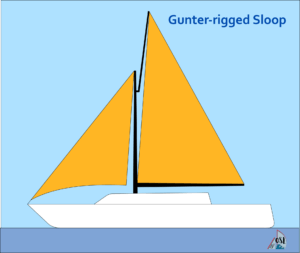
This design was popular in the 19th century because it allowed sailors to carry more sail area without having to use taller masts. However, it fell out of favor in the early 20th century when newer designs were developed that provided better performance.
Despite this, there are still some sailors who prefer the Gunter rig because of its traditional look and feel. It can also be easier to handle than some other types of rigs because the sails are smaller and lighter.
Gaff-Rigged Sloop
The gaff-rigged sloop is similar to the Gunter rig in that it uses a gaff rigged mast with an additional spar called the gaff topsail. However, it also features a headsail like the Bermuda rig.

In the past, boats commonly used gaff rigged sails, but now they have mostly been replaced by Bermuda rig sails. These newer sails are simpler than the gaff rig and allow boats to sail closer to the wind.
Spritsail Sloop
The spritsail sloop is one of the simplest rigs available. It features a single sail called the spritsail, which is attached to a spar called the sprit. This design was popular among fishermen and other working boats because it was easy to set up and maintain.

Although not as popular as before, some sailors still prefer the simplicity of a spritsail rig. It’s a great option for those who want to focus on sailing without the added complexity of multiple lines or sail plans. This type of rig is also suitable for beginner sailors and those who want an easy-to-handle boat.
The Origin of the Word Sloop
The word “sloop” is believed to have originated from the Dutch word “sloep”, which means a small boat used for fishing or transportation. The Dutch were known for their seafaring skills and had a significant influence on maritime culture in Europe during the 17th century. As such, it’s no surprise that many nautical terms used today have Dutch origins.
In fact, the sloop was initially developed in Holland during the 16th century as a small, single-masted vessel used primarily for fishing and coastal trading. These boats were highly maneuverable and could navigate shallow waters with ease, making them ideal for use in Holland’s many canals and waterways.
As Dutch sailors began to explore further afield, they brought their sloops with them, using them as auxiliary vessels to transport goods and personnel between larger ships and shore. Over time, sloops evolved into larger vessels capable of longer voyages and more extensive cargo capacity.
History of Sloops
Sloops have been a popular type of ship for centuries, with their unique rigging and hull design allowing for greater speed and maneuverability compared to other vessels. Let’s take a closer look at the history of sloops and how they have evolved over time.
17th Century: The Birth of Sloops
Sloops first emerged in the 17th century as small, fast ships used for coastal trading and piracy. Their single mast and fore-and-aft sail plan allowed them to navigate shallow waters with ease, making them ideal for smuggling goods or evading authorities. Despite their reputation as pirate ships, sloops were also used by legitimate traders due to their speed and efficiency.
18th Century: Sloops in War
In the 18th century, sloops became increasingly popular among naval forces due to their speed and agility. The British Royal Navy used sloops as dispatch vessels and reconnaissance ships during times of war. Pirates and privateers also favored sloops due to their ability to outrun larger vessels. As a result, the term “sloop-of-war” was coined to describe a small warship with a single mast and crew of around 75 men.

19th Century: Racing Sloops
The 19th century saw the rise of yacht racing, with sloops becoming a popular choice among sailors due to their versatility and ease of handling. In fact, the first recorded yacht race took place in 1826 between two sloops on the Hudson River. Sloops continued to be used for racing throughout the century, with improvements in rigging and hull design leading to faster vessels.
Modern Times: Versatile Sloops
Today, sloops are still widely used for racing and cruising due to their versatility. They are often chosen by recreational sailors who want an easy-to-handle vessel that can navigate both shallow coastal waters and open seas. Modern sloops come in various sizes, from small day-sailers to larger cruising boats. Some sloops even incorporate multiple masts, such as the ketch rig , which features a smaller mizzen mast behind the main mast.
Advantages of a Sloop
Single mast: easier to handle and maneuver.
Sloops are popular sailboats that have a single mast, which makes them easier to handle and maneuver compared to other sailboat types. The simplicity of the sloop rig means that it requires less maintenance and is generally less expensive to maintain compared to other sailboat types. With only one mast, there are fewer lines and sails to manage, making it easier for sailors who are new to sailing or those who prefer a simpler setup.
The single mast design also allows for better visibility on the water since there is no obstruction from multiple masts or rigging. This feature is especially useful when sailing in crowded waters where you need to keep an eye out for other boats or obstacles.
Faster Sailing and Closer to the Wind
Another advantage of sloops is their speed. Sloops are generally faster than other sailboat types due to their streamlined design with fewer sails. The Bermuda sloop, for example, has a triangular mainsail and one or more headsails, allowing it to move quickly through the water with minimal drag.
Sloops can also sail closer to the wind than most other sailboats. This means they can tack (sail against the wind) more efficiently, allowing them to cover more ground in less time. The ability of a sloop’s sails to be adjusted easily helps in this regard as well.
Wide Variety Available
As the most popular contemporary boat, sloops are available in a wide variety. They come in different sizes and designs suitable for various purposes such as racing, cruising, or day sailing. Some sloops even have additional sails like mizzenmast or more headsails which make them more versatile.
For instance, some sloops have a mizzenmast located aft of the mainmast which provides additional support for larger boats during heavy winds. Other sloops may have multiple headsails that allow them greater flexibility when adjusting to different wind conditions. These additional sails can make a sloop more expensive to maintain, but they also provide greater versatility and options for the sailor.
Disadvantages of a Sloop
Limited sail options in heavy weather conditions.
Sloops are known for their simplicity and ease of handling, but they have some disadvantages that sailors should be aware of. One of the biggest drawbacks is the limited sail options in heavy weather conditions. Sloops typically have a single forestay that supports the mast, which means that they can only fly one headsail at a time. This can be problematic when sailing upwind in strong winds or heavy seas.
In these conditions, it’s often necessary to reduce sail area to maintain control and prevent damage to the boat or rigging. With a sloop, this usually means taking down the headsail and relying on the mainsail alone. While this can work well in moderate wind conditions, it may not provide enough power or stability in stronger winds.
Difficulty in Handling Larger Sails Alone
Another disadvantage of sloops is that they can be difficult to handle when sailing with larger sails alone. As mentioned earlier, sloops rely on a single forestay to support the mast and headsail. When you increase the size of the sail, you also increase the load on the forestay and rigging.
This means that you may need additional crew members to help manage larger sails safely. If you’re sailing solo or with a small crew, this can make it challenging to get the most out of your boat without putting yourself at risk.
Higher Loads on Mast and Rigging Due to Single Forestay Design
The single forestay design used by sloops also puts higher loads on both the mast and rigging compared to other sailboat designs. The forestay is responsible for supporting not only the headsail but also part of the mast itself.
This means that any stress placed on the headsail or rigging will be transferred directly to the mast through this single point of attachment. Over time, this can lead to fatigue and wear on both the mast and rigging components.
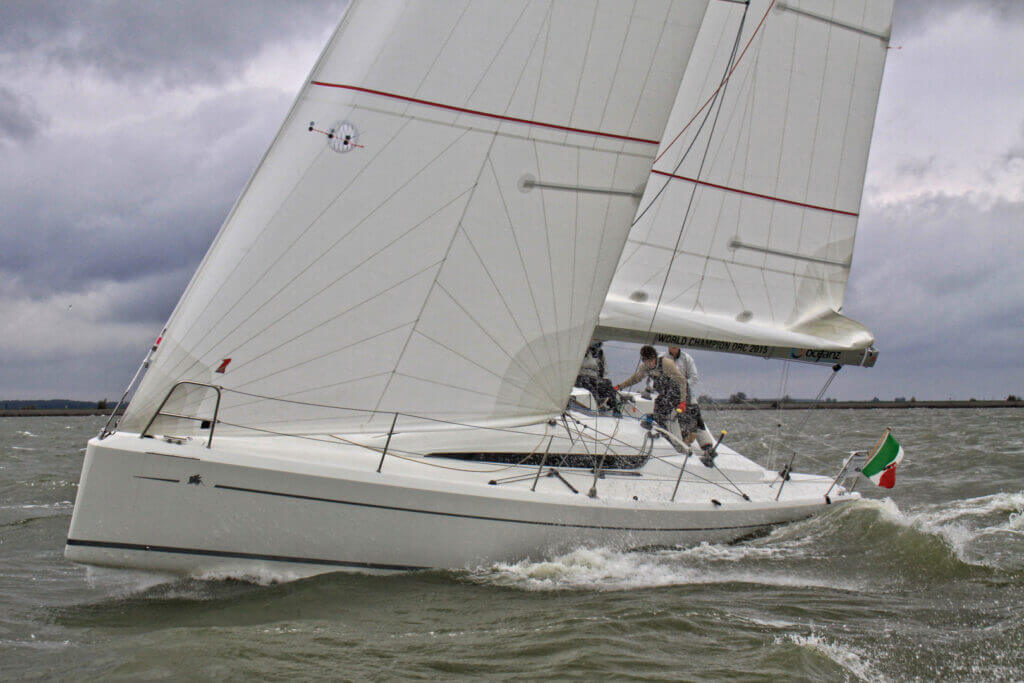
Increased Risk of Broaching in Strong Winds
Sloops are also more prone to broaching in strong winds compared to other sailboat designs. Broaching occurs when a boat is hit by a large wave or gust of wind from the side, causing it to heel over and potentially capsize.
Because sloops have a smaller cockpit and rely on a single forestay for support, they may be more susceptible to this type of event. This can be especially dangerous if you’re sailing in rough conditions or offshore where rescue may not be immediately available.
Reduced Stability Compared to Other Sailboat Designs
Another disadvantage of sloops is that they offer reduced stability compared to other sailboat designs. Sloops typically have a narrower beam and less ballast than other boats of similar size, which can make them feel less stable in heavy seas or choppy water.
This lack of stability can also affect your ability to maintain course and steer accurately, especially when sailing upwind or in challenging conditions. It’s important to understand the limitations of your boat and adjust your sailing style accordingly.
Conclusion: What is a Sloop?
With just one mast and a fore-and-aft rig, sloops are known for their simplicity and versatility. These characteristics make them an excellent choice for sailors of all levels. Whether you’re a seasoned sailor or just starting out, you’ll find that the design of a sloop allows for easy handling and maneuverability.
The single mast on a sloop is typically located towards the front of the boat. This placement provides several advantages when sailing upwind, the sail can be adjusted easily to maintain an optimal angle with respect to the wind. This is because there is only one sail to worry about, unlike other types of boats that may have multiple sails.
Similarly, when sailing downwind, a sloop’s sail can be adjusted quickly to take advantage of any changes in wind direction or speed. This flexibility makes it possible to navigate challenging weather conditions with ease.
External Links, See Also
For those looking for more technical information on sloops and other types of sailboats, the Boatdesign.net forum is an excellent resource. Here you can find discussions on everything from mast design to hull construction.
Finally, if you’re looking for some great books on sailing and sailboat design, be sure to check out “The Elements of Seamanship” by Roger C. Taylor or “Sailing Alone Around the World” by Joshua Slocum.
Similar Posts
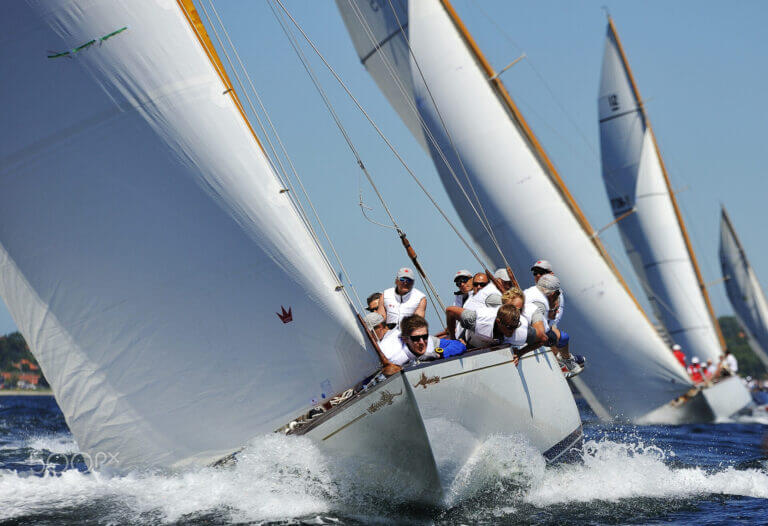
How Much Does Biofouling Slows Down your Boat?
Are you wondering how much biofouling can impact the performance of your sailboat? The amount of how much biofouling slows down a sailboat depends on various factors, such as the type of boat, its size, and the severity of the biofouling. On average, a sailboat with a heavily fouled hull can experience a reduction in…

Basic Sailing Terminology: Sailboat Parts Explained
Sailing is a timeless activity that has captivated the hearts of adventurous souls for centuries. But, let’s face it, for beginners, sailing can be as intimidating as trying to navigate through a dark, labyrinthine maze with a blindfold on. The vast array of sailing terminology, sailboat parts and jargon can seem like a foreign language…

How Does a Marine Toilet Work?
Have you ever wondered how a marine toilet works? If you’re planning to embark on a boating adventure or just curious about the mechanism of a marine toilet, this article is for you. Marine toilets work similarly to the ones on land with a bowl, a seat, and a flushing mechanism that uses water. However,…

What is a Ketch Sailboat?
Ketch boats are frequently seen in certain regions and offer various advantages in terms of handling. However, what is a ketch and how does it stand out? A ketch is a sailboat with two masts. The mainmast is shorter than the mast on a sloop, and the mizzenmast aft is shorter than the mainmast. Ketches…
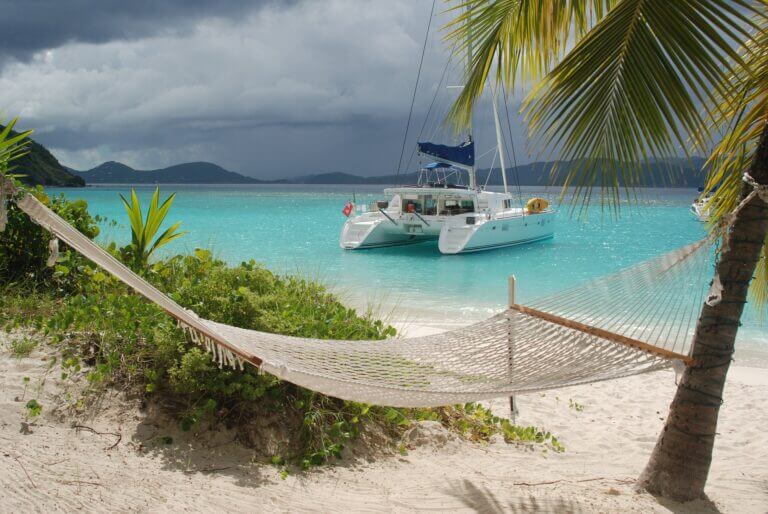
Advantages of Catamaran Sailboat Charter
A catamaran sailboat charter is an exciting way to explore the beauty of the sea. Whether you are an experienced sailor or a first-timer, booking a catamaran sailboat charter has a lot of advantages that you can enjoy. In this article, we will discuss the advantages of booking a catamaran sailboat charter, so that you…
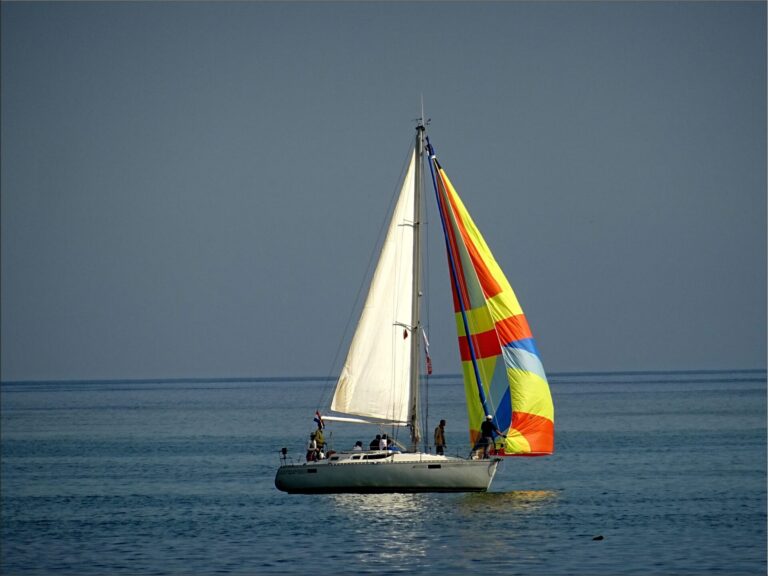
Types of Sails: A Comprehensive Guide
In the enchanting world of sailboat dynamics, where the dance between wind and water takes center stage, the significance of sails cannot be overstated. Like the wings of a bird, these meticulously crafted sails unfurl to catch the slightest whisper of breeze, converting it into a powerful forward thrust that carries us through the vast…
Sloop Rigging: A Comprehensive Guide for Sailors
by Emma Sullivan | Aug 22, 2023 | Sailboat Maintenance
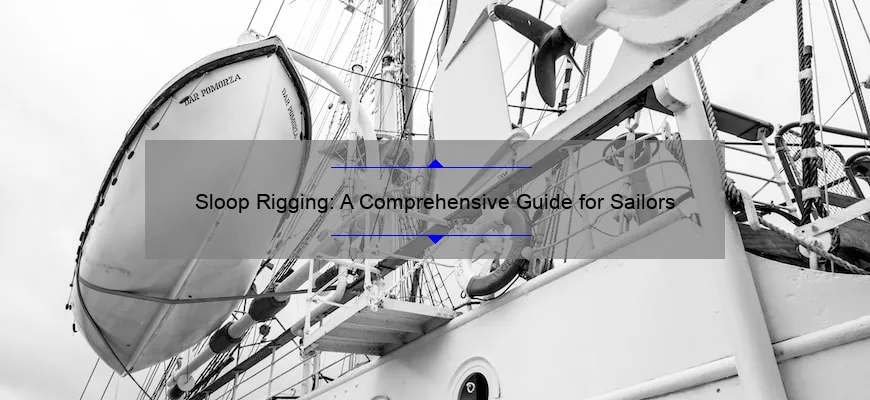
== Short answer: Sloop rigging == Sloop rigging refers to a type of sailboat rigging that consists of a single mast with one mainsail and one headsail. This configuration allows for simpler handling and better upwind performance than other types of rigs. Sloop rigging is commonly used in smaller sailing vessels.
Understanding Sloop Rigging: A Comprehensive Guide
In the world of sailing, knowledge of rigging is crucial for any sailor looking to navigate the high seas with skill and finesse. Among the various rigging types out there, the sloop rigging is one that truly stands out. A sloop rig consists of a single mast with a fore-and-aft mounted mainsail and a jib or genoa up front. This particular configuration offers great versatility and efficiency, making it highly popular among sailors worldwide.
But what makes sloop rigging so special? In this comprehensive guide, we will delve into the intricacies of sloop rigging, equipping you with the knowledge needed to fully understand and appreciate this remarkable technique.
1. Anatomy of Sloop Rigging: To truly grasp sloop rigging, it’s essential to understand its components . The key elements of a sloop rig include the mast – which provides vertical stability – along with its associated standing and running rigging. Standing rigging refers to the fixed lines that hold the mast in place, such as shrouds and stays . Running rigging comprises lines used to control sails’ position and trim, including halyards, sheets, and control lines.
2. Sail Control: One of the main advantages of sloop rigs lies in their ability to offer precise sail control. By having just one mast and two sails – mainsail and jib/genoa – sailors have more flexibility in adjusting their sail setup according to wind conditions. Unleashing or reducing sail area becomes effortless through proper trimming techniques using halyards and sheets.
3. Upwind Performance: When heading upwind (sailing towards where the wind is coming from), sloop rigs display excellent performance due to their aerodynamic design. The mainsail acts as a powerful driving force while utilizing the jib/genoa alongside helps create additional lift upwind by maximizing airflow over both sails.
4. Downwind Maneuverability: The versatility of sloop rigs truly shines when sailing downwind . By adjusting the sails’ positioning, sailors can effectively harness the power of the wind and ride it with finesse. In lighter winds, deploying a spinnaker – a specialized downwind sail – can further enhance the sloop rig’s performance by generating extra lift and speed.
5. Simplified Handling: Compared to more complex rigging types like ketch or schooner, sloop rigging offers simplified handling due to its streamlined setup. This simplicity enables sailors to make quick adjustments while maintaining optimum control even in demanding conditions. Being able to handle a boat efficiently promotes confidence and ease on the water.
6. Single-handed Sailing: Another significant advantage is that sloop rigs are well-suited for single-handed sailing. With fewer sails and lines to manage, solo sailors can easily handle their boat without relying heavily on crew members. The ability for one sailor to navigate comfortably encourages more independence on the water and opens up exciting opportunities for solitary adventures .
7. Offshore Capabilities: Sloop rigs have proven their worth time and again in offshore passages around the world, demonstrating remarkable stability and reliability even in rough conditions. Their ability to handle heavy weather with reduced sail areas ensures enhanced safety while maintaining satisfactory performance during long-distance journeys.
In conclusion, understanding sloop rigging is crucial for all sailors seeking proficiency and success on the water. Its versatility, simplified handling, and exceptional upwind performance make it a top choice among both recreational cruisers and competitive racers alike. Whether you’re planning short coastal trips or embarking on grand oceanic voyages, mastering this comprehensive guide will undoubtedly steer you toward becoming a skilled sailor capable of taming any maritime challenge with grace and confidence.
How to Rig a Sloop: Step-by-Step Instructions for Beginners
Are you a beginner in the world of sailing and eager to learn how to rig a sloop? Well, you’re in luck because we’ve got you covered! In this step-by-step guide, we will walk you through how to rig a sloop like a pro.
But first, let’s answer an important question: What is a sloop? A sloop is a sailing vessel with one mast and two sails – a mainsail and a jib. While rigging may sound daunting, don’t fret! With our easy-to-follow instructions, you’ll be setting sail in no time.
Step 1: Gather the Essentials Before beginning the rigging process, make sure you have all the necessary equipment ready. You’ll need your sails (mainsail and jib), mast, boom, standing rigging (shrouds and forestays), halyards, sheets, blocks, cleats, and various fittings. Having everything at hand ensures smooth progress throughout the process.
Step 2: Prepare the Mast Start by positioning your mast vertically on deck or on its base. Secure it firmly using mast supports or wedges if needed. Ensure that nothing obstructs its base as it should sit securely in its step.
Step 3: Attach Shrouds and Forestay Next up is attaching the shrouds (the cables supporting the mast sideways) and forestay (the cable preventing forward movement of the mast). Attach these carefully to their respective points on both sides of the boat ‘s hull. Adjust tension later but make sure they are properly secured initially.
Step 4: Hoist the Mainsail Now comes the exciting part! Attach one end of your mainsail halyard to the headboard of your mainsail and run it through the reefing cringles neatly fixed along one side of your mainsail. Slowly hoist it up by pulling on the other end of the halyard, ensuring it slides smoothly through the masthead sheave. Keep the sail’s luff straight along the mast as you raise it.
Step 5: Secure the Mainsail Once your mainsail is fully hoisted, secure the halyard to the mast cleat or winch. Adjust any necessary tension on your shrouds and forestay to ensure proper alignment of the sail without excessive luffing or sagging.
Step 6: Attach Boom and Fix Jib Sheets Now turn your attention to attaching the boom (the horizontal spar supporting the foot of your mainsail) to its gooseneck fitting located at the base of your mast. Double-check that all connections are secure and functioning correctly. Afterwards, fix jib sheets (lines attached to each side of your jib sail) to their respective clew points.
Step 7: Hoist and Trim Jib Raise your jib by attaching one end of its halyard to its headboard and hauling it up using a similar process as hoisting the mainsail. Once raised, trim the jib sheet lines until there’s just enough tension for a slight curvature inwards towards the hull – this enhances aerodynamics while sailing .
Congratulations! You’ve successfully rigged a sloop like a pro! Now that you have completed these steps, take some time to admire your accomplishment before setting off on an unforgettable sailing adventure .
Remember, practice makes perfect. Rigging a sloop can seem intimidating at first, but with repetition and experience, you’ll become more confident in no time. Whether you’re cruising tranquil waters or participating in exhilarating races, mastering these techniques will surely enhance your sailing skills.
Happy sailing and fair winds !
Frequently Asked Questions about Sloop Rigging: Explained
Sloop Rigging: Frequently Asked Questions Explained
Are you considering purchasing a sailboat or currently own a sloop-rigged vessel ? If so, you probably have some burning questions about sloop rigging. Fear not! We’ve got you covered with this detailed guide that will unravel the mystery behind frequently asked questions about sloop rigging.
Question 1: What is sloop rigging?
Sloop rigging refers to the configuration of a sailboat ‘s mast, boom, and sails. In a traditional sloop rig, there is a single mast located at the front of the boat called the mainmast, and it carries one mainsail. The mainsail extends from the top of the mast to the boom, which is attached near its bottom end. Additionally, there is usually a jib or genoa headsail up front. This simple yet effective configuration allows for easy handling and versatility when sailing .
Question 2: Why choose a sloop-rigged sailboat ?
The popularity of sloop rigging stems from its simplicity and efficiency. The design provides excellent balance between power and maneuverability while being relatively easy for solo sailors to handle. Sloop-rigged boats are also versatile enough to navigate various wind conditions effectively. Whether you’re racing or cruising, it offers fantastic performance on both points of sail (upwind and downwind). It’s no wonder why many recreational boaters and even seasoned sailors favor this rigging setup.
Question 3: What types of sails are used in sloop rigs ?
Singles ailboats employ various types of sails within the sloop rig system:
– Mainsail: This is the primary driving force in most sailing scenarios as it captures wind from behind. – Headsail: Also known as either a jib or genoa, this foresail acts as an auxiliary source of power that enhances maneuverability and speeds up sailing in light winds. – Spinnaker: Typically used in downwind conditions, this large, balloon-like sail helps catch wind from the side and propels the boat forward. It’s often utilized during racing or leisurely cruising for an extra boost of speed.
Question 4: How do you control the sails in a sloop rig?
Sail control on a sloop-rigged vessel involves several lines, each serving to adjust different aspects of the sails’ shape and position:
– Halyards: These lines raise and lower the mainsail and headsails. – Sheets: Attached to the clew (lower corner) of each sail, these lines allow you to trim (adjust) the sails according to wind direction and boat speed. – Furling Systems: Frequently employed with headsails, furling systems enable easy deployment or stowing by rolling or “furling” the sail around its own luff wire.
Understanding how to manipulate these control lines will offer better control over your sloop rigging’s performance while sailing .
Question 5: Can I run aground using a sloop rig ?
While every sailor fears running aground, fear not! The design of a sloop rig with its comparatively shallow draft makes it less prone to grounding. This advantageous characteristic is due to most of the ballast weight being located at a deeper keel that allows for enhanced stability without sacrificing maneuverability. Therefore, as long as you exercise caution and watch water depths carefully, running aground should be avoided under normal circumstances.
In summary, sloop rigging provides sailors with a reliable and efficient sailing experience. Its simplicity and versatility make it an excellent choice for both novice sailors and seasoned seafarers. With proper understanding of how to handle its various components effectively, you’ll be ready to tackle any adventure that awaits you on the open waters!
Mastering the Art of Sloop Rigging: Tips and Techniques
Welcome to our blog post on mastering the art of sloop rigging! Whether you’re a seasoned sailor or just starting out, understanding and perfecting the techniques involved in sloop rigging is essential for smooth sailing. In this informative and comprehensive post, we’ll teach you all the tips and techniques you need to become a master at sloop rigging.
Firstly, let’s start with some basic knowledge. The term “sloop” refers to a specific type of sailboat that has a single mast and a fore-and-aft rig configuration. This design allows for simple handling and efficient sailing in most conditions. However, it does require proper rigging skills to ensure optimal performance.
One key tip when it comes to sloop rigging is maintaining proper tension in your standing rigging. This involves checking and adjusting the tension regularly so that the wires or cables supporting your mast are neither too loose nor too tight. Proper tension ensures stability and minimizes stress on the entire rig system during sailing.
Another technique that can greatly enhance your sloop rigging skills is properly trimming your sails. Trimming refers to adjusting the shape and angle of your sails in response to wind conditions, optimizing performance and speed. It requires keen observation and swift reactions to changes in wind direction and strength.
To achieve precise sail trimming, consider investing in modern technology such as telltales or wind indicators that provide visual cues about airflow around the sails . These tools can immensely assist you in achieving maximum efficiency by helping identify areas where adjustments are needed.
Furthermore, mastering the art of sloop rigging also entails understanding how different components work together harmoniously. From halyards to sheets, shrouds to forestays – each piece plays a crucial role in maintaining balance while distributing loads effectively throughout your boat ‘s structure.
Knowing how various lines are rigged enables quick adjustments when necessary. Are you familiar with clew outhauls or cunninghams? These adjustments are hidden gems that can fine-tune the shape of your sails, allowing you to utilize every ounce of power from those prevailing winds.
However, it is essential to remember that mastery is not achieved overnight. Like any skill worth acquiring, sloop rigging demands practice and continuous improvement. So, grab any opportunity to hit the water and put your newly acquired knowledge into action!
In addition to these technical tips and techniques, let’s not forget the importance of safety in sloop rigging. Remember always to wear appropriate personal flotation devices and harnesses when working aloft. Additionally, never neglect routine inspections and maintenance of your rigging system.
To summarize, mastering the art of sloop rigging requires a combination of technical knowledge, practicality, and dedication. Regular maintenance and inspections alongside accurate sail trimming will help optimize performance while keeping you safe on the water .
So embrace the challenge and set sail with confidence! With these tips and techniques under your belt, you’ll soon be navigating choppy seas like a true master of sloop rigging.
The Importance of Proper Sloop Rigging Maintenance
Proper Sloop Rigging Maintenance: Safeguarding Sailors and Sailboats to Sail Smoothly
When it comes to sailing, the importance of proper sloop rigging maintenance cannot be overstated. Rigging plays a crucial role in ensuring the safety and efficiency of a sailboat. Neglecting this vital aspect can lead to disastrous consequences such as rig failures, compromised boat performance, or even accidents at sea.
Rigging refers to the network of cables, ropes, and fittings that support and control the sails on a sloop rig – the most common sail plan found in modern sailboats. Just like the intricate web of a spider’s silk keeps it secure, sloop rigging is responsible for keeping your mast upright, supporting your sails in optimal positions, and allowing you to harness the power of wind effectively.
Regular maintenance of rigging should never be overlooked by any sailor who values their safety and wants to enjoy smooth sailing experiences. Here are some key reasons why proper sloop rigging maintenance is essential:
1. Safety First: Your Personal Lifeline One cannot stress enough how critical it is to have structurally sound rigging. Imagine being miles away from land when suddenly encountering rough weather conditions or unexpected gusts of wind. Faulty or worn-out rigging can snap under such pressure, leading to partial or total failure of your entire mast system. This can not only endanger your life but also put other crew members at risk. Regular inspections and maintenance ensure that your lifeline – your sloop’s rigging – remains reliable even in challenging circumstances.
2. Optimum Performance: Sail with Confidence Sailors crave smooth rides across calm waters or thrilling adventures amidst choppy seas; however, when neglected, rigging issues can quickly turn any expedition into an unsettling experience. Properly maintained rigging minimizes unnecessary friction between ropes and pulleys while optimizing sail shape adjustment capabilities throughout various wind angles. This, in turn, allows you to maintain precise control over your boat ‘s speed and direction, boosting your confidence on the water. Well-serviced rigging will enable you to harness the wind efficiently, making each voyage a delight rather than a struggle.
3. Catch Problems Early: Prevention is Key An often overlooked advantage of proper rigging maintenance lies in its ability to identify potential issues before they escalate into major headaches. Routine inspections can detect various problems such as worn-out wires, damaged fittings, or weakened connections – all of which have the potential to lead to critical failures if left unattended. By addressing these concerns promptly, you can save yourself from costly repairs or even having to replace entire sections of rigging down the line.
4. Increased Lifespan: Invest in Longevity Just like any mechanical system requires regular care and maintenance for prolonged functionality, sloop rigging is no exception. With time, everyday wear and tear can take their toll on individual components of your rigging setup. However, with regular cleaning, lubrication, and replacement of worn parts as needed – ideally performed by experienced professionals – you will significantly extend the lifespan of your rigging system. Investing time and resources into proper maintenance pays off in uninterrupted years filled with memorable sailing adventures .
5. Showcasing Professionalism: Attention to Detail Beyond safety and performance perks gained from maintaining your sloop’s rigging properly lies another subtle advantage – a mark of professionalism that sets great sailors apart from amateurs. By demonstrating awareness and vigilance towards the condition and well-being of your rigging setup, you display respect for both the sport itself and those sharing the waters with you. This attention to detail exudes an aura of competence that fellow sailors recognize and respect.
In conclusion, neglecting proper sloop rigging maintenance is an unfortunate gamble no sailor should take lightly. From ensuring crew safety during rough weather or unexpected gusts to maximizing boat performance and extending the rigging’s lifespan, the reasons to prioritize maintenance are compelling. So, arm yourself with knowledge, seek professional guidance when needed, and remember: maintaining your sloop rigging is not just an obligation – it’s a seafaring responsibility that paves the way for countless extraordinary voyages on the horizon.
From Start to Finish: A Complete Overview of Sloop Rigging Steps
Title: From Start to Finish: A Complete Overview of Sloop Rigging Steps
Introduction: Sloop rigging is a crucial aspect of sailboat maintenance, ensuring the boat’s stability and performance on the water. Whether you’re a seasoned sailor or just starting out, understanding the step-by-step process of sloop rigging is essential for safe and enjoyable voyages. In this comprehensive guide, we will take you through each stage from start to finish, equipping you with the knowledge needed to tackle any rigging task with confidence.
1. Assessing Your Sailing Vessel: Before diving into the world of sloop rigging, it’s vital to assess your sailing vessel thoroughly. This involves inspecting the mast, boom, standing rigging components (such as shrouds and stays), running rigging elements (like halyards and sheets), and fittings (turnbuckles, cleats, etc.). Any signs of wear and tear must be identified and addressed promptly.
2. Gathering Essential Tools and Materials: To execute successful sloop rigging maintenance, gather all necessary tools and materials beforehand. This includes appropriate wrenches, pliers, wire cutters or hydraulic crimpers (for replacing cables), tape measure or ruler, marine lubricant for moving parts like turnbuckles or blocks, professional-grade sailing hardware if replacements are required – ensure their compatibility with your vessel’s specifications.
3. Loosening Standing Rigging: Begin by loosening up the standing rigging – shrouds and stays that keep your mast in position. Carefully release tension from these components using a wrench or specialized tension gauge following boat manufacturer guidelines . Proper adjustment ensures an adequate balance between tension requirements for optimal performance while minimizing undue stress on mast sections.
4. Inspecting Running Rigging Elements: After addressing standing rigging adjustments comes a thorough inspection of running rigging elements – halyards (lines used to raise sails), sheets (lines used to control sail positions), and blocks. Check for any signs of fraying, chafing, or mal functioning blocks that can affect their functionality while sailing . Replace damaged components promptly using appropriate hardware .
5. Maintaining Turnbuckles: Turnbuckles are mechanical devices used to tension the standing rigging wires correctly. Regular maintenance is essential to ensure their smooth operation and prevent seizing or corrosion over time. Dismantle each turnbuckle individually, lubricate with marine-grade lubricant, and reassemble following manufacturer instructions.
6. Replacing Old Cables: If any standing rigging cables show visible signs of significant wear, it’s crucial to replace them promptly to maintain a safe sailing environment. Using wire cutters or hydraulic crimpers, disconnect old cables from their attachments and install new ones as per manufacturer recommendations.
7. Reassembling Components: After addressing specific components separately, it’s time to reassemble the entire sloop rigging system carefully. Begin by reconnecting newly installed cables onto their respective attachments – turnbuckles, tangs, chainplates – verifying secure connections throughout the process. Ensure proper alignments and tighten all fasteners adequately.
8. Tensioning Standing Rigging: Once everything is securely assembled, proceed with tensioning the standing rigging components according to your vessel’s specifications or expert guidelines provided by its manufacturer or naval architect. This step typically involves adjusting turnbuckles until achieving the recommended level of tension while maintaining reasonable flexibility in the mast .
9. Final Checks and Testing: With your sloop rigging now properly tensioned, conduct a final comprehensive inspection ensuring all connections remain secure and without defects before taking your boat back on water. Perform various tests like hoisting/reefing sails or maneuvering different lines under various load conditions in a controlled environment to ensure optimal performance.
Conclusion: Sloop rigging plays a vital role in sailboat performance and safety. By following this comprehensive overview, you are now equipped with the knowledge required to tackle sloop rigging tasks confidently from start to finish. Regular inspections, maintenance, and prompt repairs/replacements will keep your vessel sailing smoothly while ensuring a pleasurable and secure voyage.
Recent Posts

- Sailboat Gear and Equipment
- Sailboat Lifestyle
- Sailboat Maintenance
- Sailboat Racing
- Sailboat Tips and Tricks
- Sailboat Types
- Sailing Adventures
- Sailing Destinations
- Sailing Safety
- Sailing Techniques

- News & Views
- Boats & Gear
- Lunacy Report
- Techniques & Tactics
CRUISING SAILBOAT RIGS: Sloops, Cutters, and Solent Rigs
In our previous episode in this series we discussed what I like to call split rigs–ketches, yawls, and schooners–where a sailplan is divided among two or more masts. Cruising sailors once upon a time preferred such rigs, at least on larger cruising boats, because each separate sail requiring handling was smaller and thus more manageable. These days, however, by far the most popular rig for both racing and cruising sailboats is the simple sloop rig. This has a single mast supporting a single Marconi mainsail with a single headsail supported by a single headstay flying forward of it.
Its advantages are manifest: there are only two sails for the crew to handle, each of which can be hoisted with a single halyard and trimmed with a single sheet. While sailing, there are normally only two lines–the jib sheet and mainsheet–that need to be controlled at any given moment. And because there is but one headsail flying forward of the main, tacking a sloop is easy, since the headsail, even if it is a large overlapping genoa, can pass easily through the open foretriangle.
Sloop rigs are highly efficient to windward, thanks to the so-called “slot effect” created by the interaction of the mainsail and headsail. How this actually works is a matter of some debate. The traditional theory is that airflow in the narrow slot between the sails is accelerated, which decreases air pressure on the leeward side of the mainsail, thus increasing the lift the sail generates.
The revisionist theory is that air deflected from the headsail actually works to decrease airflow in the slot, increasing pressure on the windward side of the headsail, thus increasing the lift it generates. Since increasing the lift generated by one sail seems to necessarily decrease that generated by the other, others believe a single Marconi sail must be just as aerodynamic, if not more so, than two sails. This last proposition, however, is contradicted by real-world experience, as no one has yet created a single-sail rig that is as fast and closewinded as a double-sail sloop rig.
The almighty slot in action. Its effects are salubrious, but no one can really explain why
The primary disadvantage of a sloop rig is that the sails must be relatively large. They are therefore harder to handle in that they are heavier (making them harder to hoist) and generate larger loads when flying. Much of this difficulty, however, is obviated by modern winches and roller-furling gear, which is why sloop rigs are now so popular, and deservedly so. In light to moderate sailing conditions, which is what most sailors normally encounter, a sloop is by far the fastest, most easily handled rig currently available.
In heavier conditions sloops do present some challenges. To reduce sail area forward of the mast, if the headsail is hanked on to the headstay, which was the traditional practice, you must change the sail for a smaller one. This requires crew to work for extended periods on the bow of the boat, where conditions can get wild and wet. If the headsail is on a modern roller-furler, the sail can be easily roller-reefed from the cockpit, but past a certain point a roller-reefed headsail’s shape becomes inefficient. You either must live with this or unroll the sail and change it for another smaller one. The stronger the wind gets, the more distorted the roller-reefed sail becomes, and the more important it is to change it. Changing a sail on a furler in a strong wind, however, is an awful chore. The very first thing you must do (unroll the sail) greatly increases sail area right when you most want to decrease it. Then you must somehow control a large headsail as it comes off a furling rod with its luff unrestrained in strong wind.
Coastal cruisers are never likely to sail in strong conditions for very long. On the few brief occasions their boats are pressed hard they are normally willing to limp along on an ugly scrap of roller-reefed genoa. They are also more likely to have to short-tack their boats in confined areas, thus the ease of tacking a sloop makes it the rig of choice on coastal boats. Bluewater cruisers, on the other hand, may sail in strong weather for days on end, so there are advantages to cutting up the sail area in the foretriangle into smaller more manageable pieces. Bluewater cruisers traditionally therefore often prefer a cutter rig, which has a single mast and a headstay like a sloop, but also an inner forestay behind the headstay from which a smaller intermediate staysail can be flown.
Modern cutter-rigged cruiser sailing under a staysail and a reefed mainsail
The big advantage of a cutter rig is that in a big blow the jib on the headstay can come right off (or be rolled up) and the smaller staysail can carry on alone, more inboard and lower in the rig, where it balances better against the reduced area of a deeply reefed mainsail. Cutters are also efficient to windward, though some claim they are not as efficient as sloops. Personally, I’ve found cutters are sometimes actually more closewinded than sloops, at least in moderate to strong winds, as the sheeting angles on a pair of smaller, flatter headsails can be narrower than the angle on one larger, more full-bodied sail. In very heavy conditions, with just a staysail and reefed mainsail deployed, I believe a cutter is almost always more efficient to windward than a sloop.
On anything from a beam reach to a tight closehauled angle, a cutter can also fly both its headsails unobstructed. Sailing on a broad reach, however, the staysail blocks air from reaching the jib, reducing the rig’s effective sail area just when the decrease in apparent wind speed caused by the wind blowing from behind the boat demands that sail area instead be increased. Another problem is that a cutter requires extra standing rigging–not only the inner forestay, but also, very often, either an extra set of swept-back aft shrouds or a pair of running backstays to help support the inner forestay from behind. This adds complexity and increases rig weight well above the deck.
The biggest disadvantage of a cutter rig is that there are two headsails to tack (or jibe) across the boat instead of just one. There is an extra set of sheets to handle, plus the jib quarrels with the inner forestay every time it comes across the foretriangle. This is less of a problem if the jib is small and high-cut (these are called yankee jibs) so that it slips more easily through the narrow gap between the inner forestay and headstay. When flying a large genoa, however, crew must often go forward to help horse the sail around the inner forestay. If you don’t have enough crew for this, you may have to roll up part of the genoa (assuming it’s on a roller-furler) before tacking or jibing and unroll it again afterward, which is a bother. Also, if the wind grows strong again, but not so strong that you can sail on the staysail alone, you either have to change your genoa for a smaller sail or roller-reef it into an inefficient shape, which is (theoretically) precisely the conundrum that drove you to favor a cutter rig in the first place.
On a true cutter specifically designed to accommodate a staysail, the mast is usually farther aft than it would be on a sloop and/or there is a bowsprit to enlarge the foretriangle. This allows for a larger, more useful staysail and should enlarge the gap between the headstay and inner forestay so a jib can tack through more easily. A larger foretriangle also allows the jib to be larger without overlapping the mainsail, but a big overlapping genoa will still present problems when tacking or jibing.
A “true” cutter under sail. With the mast aft the foretriangle is bigger, which allows for a bigger, more useful staysail. As on this boat, a true cutter often flies a high-cut yankee jib forward of the staysail
The staysail can also be made club-footed with its own boom. Such a spar, known as a jib-boom, can be controlled by a single sheet that need not be adjusted when tacking. When short-tacking in enough breeze for the boat to sail under main and staysail alone this is the height of convenience. You can shift the helm back and forth without ever touching a line. A jib-boom, however, unless sheeted tight, will flail about the foredeck whenever its sail is luffing while being hoisted, doused, or reefed. It may harm crew on the foredeck during an accidental jibe, as it can sweep suddenly across the boat with some force unless restrained by a preventer.
A cutter-rigged cruiser with a club-footed staysail
Bear in mind, too, that enlarging the foretriangle, particularly on a boat without a bowsprit, usually means mainsail area must be reduced commensurately. In many cases the mainsail is then too small and/or too far aft for the boat to sail and maneuver under main alone. When attempting to dock, anchor, or moor under sail this can be a significant disadvantage. (Note, however, that many sloops are also often unable to maneuver under mainsail alone.)
One variation increasingly popular with bluewater cruisers is a sloop/cutter hybrid, sometimes called a slutter rig, where a removeable inner forestay is installed on what would otherwise be a straight sloop rig. The removable stay normally has some sort of quick-release mechanism at deck level that makes it easy to set up and tension the stay and to loosen and remove it. When stowed, the removeable stay is brought aft to the mast and secured.
Example of an inner forestay with a retro-fitted inner forestay with a quick-release fitting that allows the stay to be moved out of the way when desired
To a large extent, the slutter rig does offer the best of both worlds. In light to moderate winds you can stow the inner forestay and sail the boat as a straight sloop with one large genoa passing through an open foretriangle. In heavy conditions, you can set up the inner forestay, hank on a staysail, roll up or douse the large genoa, and sail the boat under main and staysail alone. Since setting up an inner forestay and hanking on a staysail is normally less taxing than stripping a large genoa off a furling rod and hoisting a smaller working jib and/or storm sail in its place, this is a viable practice.
Sometimes you see true cutters that have been converted to slutters. Here the foretriangle is normally large enough to fly two headsails simultaneously if desired, which is often not possible on a converted sloop. The downside to this arrangement is that making the inner forestay removable makes it impossible to install either a roller-furling staysail (currently a popular arrangement on cutter rigs) or a club-footed staysail.
Another variation that has appeared more recently is the so-called solent rig, where a solent stay is installed directly behind a boat’s headstay. The headstay carries a big genoa (usually on a roller-furler) that is flown in light to moderate wind, and the solent stay carries what is effectively a smaller working jib (or a “blade jib,” as some like to call them now) to fly in stronger conditions. The solent jib (which is normally larger than a staysail) can be rigged permanently on its own roller-furler, or it can be on a removable stay, as is seen on slutters and some cutter rigs.
The huge problem with a permanent solent rig is that the genoa forward on the headstay is normally so close to the solent stay that it cannot be pulled through the gap between the stays, but must be entirely rolled up and unfurled again every time the boat is tacked. In some cases the solent stay actually isn’t terribly close to the headstay, but still the top of the stay is always very close to the top of the headstay and tacking is thus always problematic. For this reason, personally, I strongly favor removable solent stays.
Typical solent rig with the two stays quite close together
On this example, the two stays are farther apart, until you get up to the masthead
One recent innovation that has made the handling of removable sails much easier are sails with torque-rope luffs that are mounted on continuous-line furlers. These were developed first on shorthanded ocean-racing boats, but are now leaking on to cruising boats with increasing frequency. For these to work the sail must usually be a lighter laminated sail rather than straight Dacron. A length of high-modulus rope especially designed to resist twisting, a torque rope so called, is sewn into the luff of the sail, which is then mounted on a removable lightweight continuous-line furling drum. Once the sail is hoisted with its torque rope tensioned it can be furled up on its own luff. It can also be taken down and stowed in a bag this way, all rolled up on itself. And it can be hoisted again while still rolled up. Handling the sail is thus very easy, as the only time it is unrolled and flying free is when you are actually flying it.
The great flexibility of a torque-rope sail actually gives you two different options if you are trying to create a solent rig. The smaller solent sail can be made a removable torque-rope sail, in which case you will be setting and flying it inside the headstay. Or you can keep a small working jib on your headstay and set up a larger removable genoa-size torque-rope sail forward of it. Sails like this have all sorts of names–Code Zero sails, screechers, gennakers, etc. The most important thing, if you are ordering one, is not what you call it, but rather that it is cut flat enough to sail efficiently to windward. Also, when flying such a sail you’ll need some sort of bowsprit forward of your headstay to carry it, and the sprit must be strong enough to carry the rig’s full headstay load when the sail flying.
The headsail arrangement on my cutter-rigged boat Lunacy . A triple-headsail sloop you might call it. The headstay and the inner forestay are permanently rigged. The screecher, as I call it, flies on its own luff forward of the headstay and is controlled with a removable continuous-line furler. The bowsprit and the plate under it were added to carry the big load the sail generates. When the screecher is flying the headstay goes slack and the screecher’s torque rope is what’s holding up the front of the mast
An IMOCA Open 60 flying a staysail on a continuous-line furler
A continuous-line furler up close and personal, removed from the rig with sail furled
Yet another option is to make the staysail in a cutter rig a removable torque-rope sail. I have seen these on shorthanded racing boats, but never on a cruising boat. I wonder sometimes if I should try it on my boat. If anyone has tried it on their boat, I do wish they would get in touch!
Related Posts

NICK SKEATES ON WYLO II: The Ultimate Barebones Cruiser and his Ultimate Dirt Simple Boat


NORTHBOUND LUNACY: Atlantic City, NJ, to Portland, ME
My last two boats–a Bristol 39 and a Warwick 47–have been sloops with inner forestays. The present Warwick has a r/f forstaysail so it’/s more or less permanent. This is a great heavy weather and offshore rig–perfect for the ocean and he Caribbean, the Med not so much. The forestayail is pretty small so it takes a considerable blow to make it the right choice.
Go easy on the torque rope idea unless a) the mast is beefed up for it b) the winches, lead blocks and the deck under the winch base on which the halyard lays are beefed up. You need to plan on having a halyard lock for the top of the torque rope AND a robust purchase to load the bottom end. THIS is how the race boats are set up Coop
Leave a Reply Cancel Reply
Save my name, email, and website in this browser for the next time I comment.
Please enable the javascript to submit this form

Recent Posts
- MAINTENANCE & SUCH: July 4 Maine Coast Mini-Cruz
- SAILGP 2024 NEW YORK: Lifestyles of the Rich and Famous
- MAPTATTOO NAV TABLET: Heavy-Duty All-Weather Cockpit Plotter
- DEAD GUY: Bill Butler
- NORTHBOUND LUNACY 2024: The Return of Capt. Cripple—Solo from the Virgins All the Way Home
Recent Comments
- Brian on THE BOY WHO FELL TO SHORE: Thomas Tangvald and Melody (More Extra Pix!)
- cpt jon on NORTHBOUND LUNACY 2023: Phase Two, in Which I Exit North Carolina via Oregon Inlet
- Sanouch on A PRINCE IN HIS REALM: The Amazing Life of Thomas Thor Tangvald
- Peter Willis on DEAD GUY: Donald M. Street, Jr.
- January 2024
- December 2023
- November 2023
- October 2023
- September 2023
- August 2023
- February 2023
- January 2023
- December 2022
- November 2022
- September 2022
- August 2022
- February 2022
- January 2022
- December 2021
- November 2021
- October 2021
- September 2021
- February 2021
- January 2021
- December 2020
- November 2020
- October 2020
- September 2020
- August 2020
- February 2020
- January 2020
- December 2019
- November 2019
- October 2019
- September 2019
- August 2019
- January 2019
- December 2018
- November 2018
- October 2018
- September 2018
- August 2018
- February 2018
- January 2018
- December 2017
- November 2017
- October 2017
- September 2017
- August 2017
- February 2017
- January 2017
- December 2016
- November 2016
- October 2016
- September 2016
- August 2016
- February 2016
- January 2016
- December 2015
- November 2015
- October 2015
- September 2015
- August 2015
- February 2015
- January 2015
- December 2014
- November 2014
- October 2014
- September 2014
- August 2014
- February 2014
- January 2014
- December 2013
- November 2013
- October 2013
- September 2013
- August 2013
- February 2013
- January 2013
- December 2012
- November 2012
- October 2012
- September 2012
- August 2012
- February 2012
- January 2012
- December 2011
- November 2011
- October 2011
- September 2011
- August 2011
- February 2011
- January 2011
- December 2010
- November 2010
- October 2010
- September 2010
- August 2010
- February 2010
- January 2010
- December 2009
- October 2009
- Boats & Gear
- News & Views
- Techniques & Tactics
- The Lunacy Report
- Uncategorized
- Unsorted comments

What is the difference between sloops, cutters, schooners, and ketches?

- A sloop rig has 1 mast, with a jib and mainsail.
- A cutter is a sloop with 2 foresails(jib, staysail) and a mainsail.
- A ketch has 2 masts. It has a foresail,main and missin. It could have a staysail, if it is a cutter ketch.
- A yawl has 2 masts, one behind the rudder post. The jigger on the 2nd mast is a control sail, not normally used for upwind power.
- A schooner has 2 masts, the 2nd mast is taller. It may also have additional masts, up to 7. Normal configuration consists of jib, staysail, foresail and main. You can add topsail, and/or yankee jib and fisherman sail.
Others include a dhow, junk, and catamaran and trimaran. Larger includes ships, barks, barkentine, brig,brigantine, and sloop of war.
- Types of Sailboats
- Parts of a Sailboat
- Cruising Boats
- Small Sailboats
- Design Basics
- Sailboats under 30'
- Sailboats 30'-35
- Sailboats 35'-40'
- Sailboats 40'-45'
- Sailboats 45'-50'
- Sailboats 50'-55'
- Sailboats over 55'
- Masts & Spars
- Knots, Bends & Hitches
- The 12v Energy Equation
- Electronics & Instrumentation
- Build Your Own Boat
- Buying a Used Boat
- Choosing Accessories
- Living on a Boat
- Cruising Offshore
- Sailing in the Caribbean
- Anchoring Skills
- Sailing Authors & Their Writings
- Mary's Journal
- Nautical Terms
- Cruising Sailboats for Sale
- List your Boat for Sale Here!
- Used Sailing Equipment for Sale
- Sell Your Unwanted Gear
- Sailing eBooks: Download them here!
- Your Sailboats
- Your Sailing Stories
- Your Fishing Stories
- Advertising
- What's New?
- Chartering a Sailboat
- Sailing Sloop
Is a Sailing Sloop the Best Rig for Cruising?
For ultimate windward performance, nothing beats a deep-fin keeled sailing sloop with a tall, high aspect ratio Bermuda rig (also known as a Marconi rig).
Low aspect ratio sails are short and squat while high aspect ones are tall and narrow, or long and narrow like the wings on a high-performance sailplane.
But unlike sailplanes - which, being unrestrained by land or water, are always heading directly into the apparent wind - we sailors aren't always beating to windward.
In fact most of us go to some lengths to avoid it if we can.
High Aspect Ratio Sloop Rig
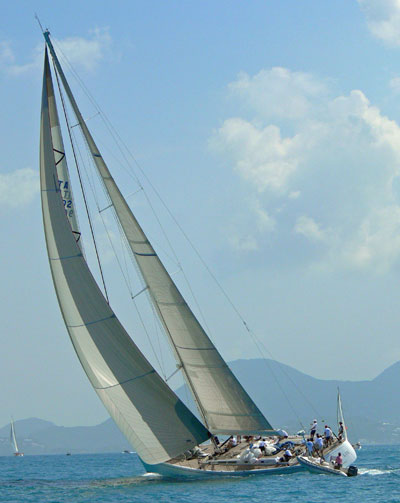
Very high aspect ratio sloop rigs like the one shown above are only really appropriate for racing sailboats, where windward performance is vital for success.
Such rigs rapidly lose their efficiency when even slightly off the wind, which is why successful racing sailboats carry an extensive sail wardrobe with sails to cater for all conditions.
This is a route we cruising sailboaters don't want to go down, so the extreme versions of sloops aren't for the likes of us, particularly as we may have difficulty of getting eight crew members to sit out when going to windward...
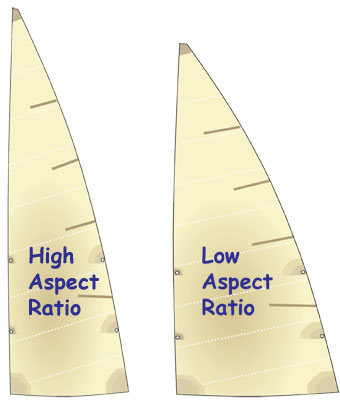
Sailing sloops with moderate rigs though, are probably the most popular of all cruising sailboats.
With just a single mast, two sails (a foresail or headsail, and a mainsail) and the minimum of rigging and sail control lines they are relatively simple to operate and less expensive than two-masted ketch rigs.
There are two sailing sloop variants - masthead rigs and fractional rigs.
Masthead Rigged Sailing Sloops
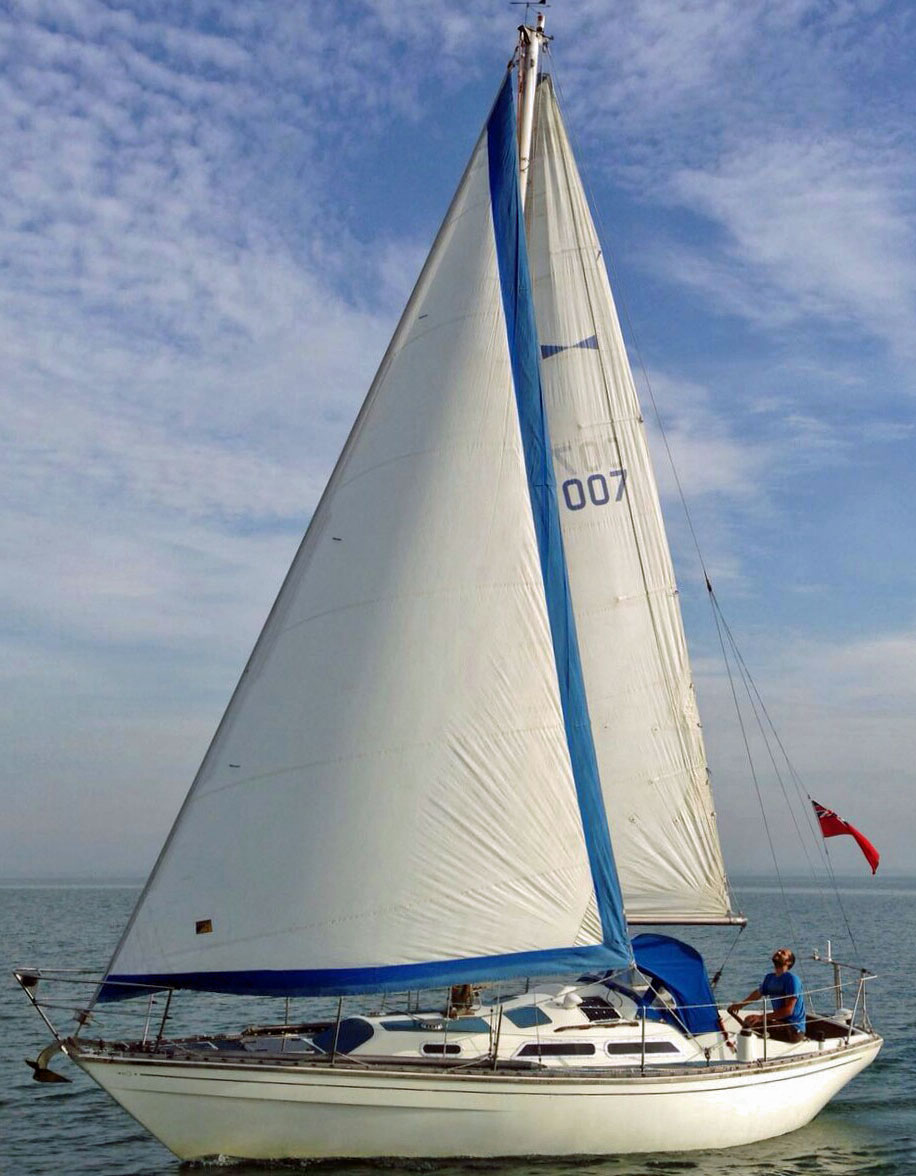
The masthead sloop is the simpler rig of the two, with the forestay attached at the top of the mast. Foresails of various sizes can be set on the forestay, from small 'working' jibs through to large 130% deck-sweeping genoas.
Incidentally, foresails are called jibs if the clew of the sail doesn't reach farther aft than the mast and genoas when it does. So the 'luff perpendicular' of a 130% genoa is 30% longer than the distance between the mast and the stemhead - known as the 'J' measurement.
Deck-sweeping genoas such as these create a wide blind-spot off the leeward bow. Unwanted surprises and chance encounters will be far fewer if the clew is cut higher, providing forward visibility from the cockpit under the foot of the sail.
Nowadays however, the headsail is set on a furling gear, with the mainsail being either slab-reefed or equipped with in-mast or in-boom furling gear .
The Double-Headed Masthead Rig
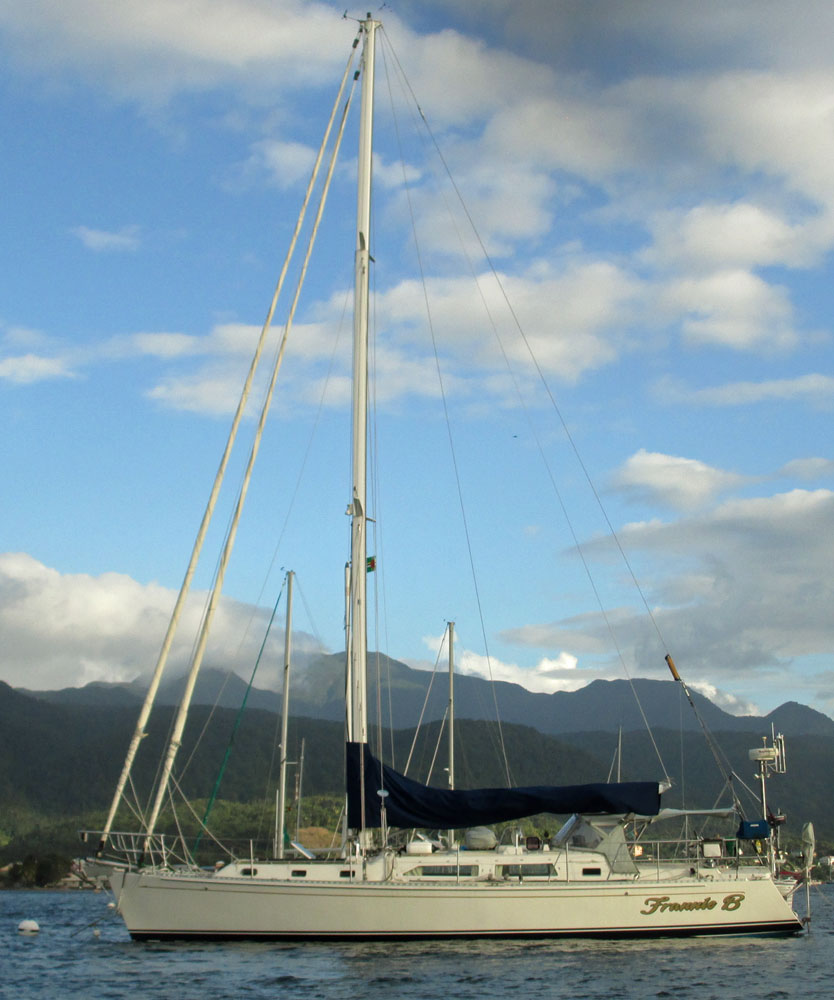
Also known as the Solent Rig , this arrangement shouldn't be confused with the cutter rig, where both foresails (a high-cut yankee and a staysail) can be set at the same time. With the double headed rig it's one or the other.
The foremost sail will be the larger of the two - often a 150% genoa - and the other perhaps a jib that just fills the fore-triangle.
With the larger sail set, it must be furled before tacking and only unfurled when the on the other tack.
Few boats come off the production line with the double headsail rig in place but it can be retro-fitted on some boats - and this article from Sail Magazine shows how...
Fractionally Rigged Sailing Sloops
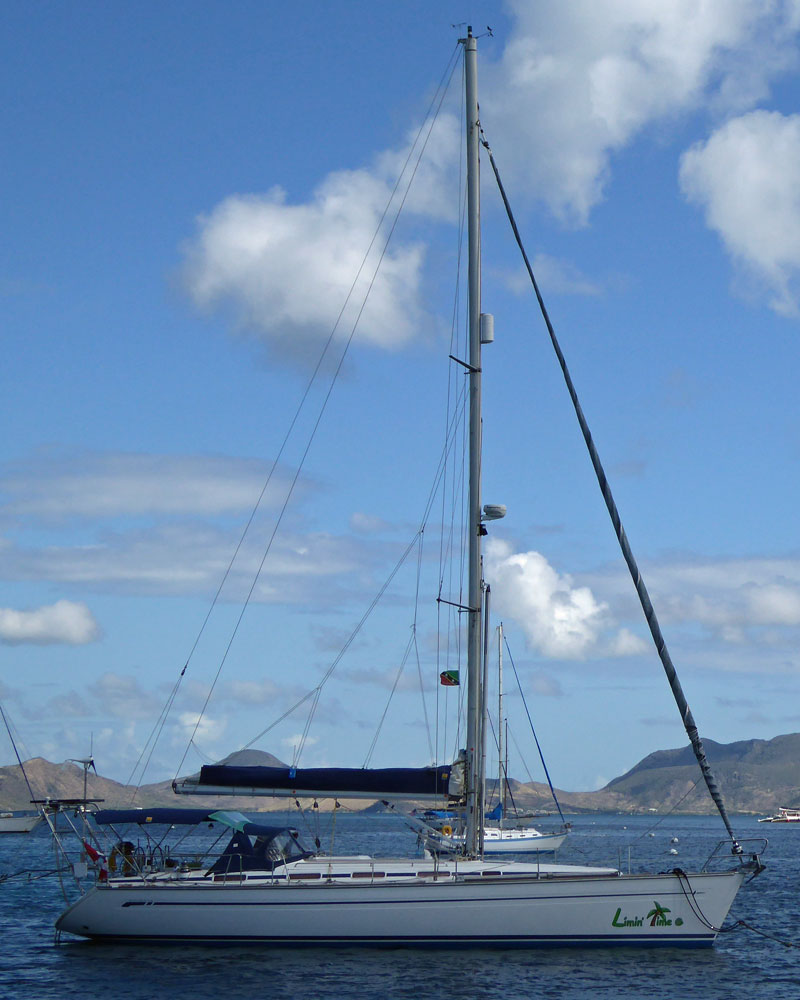
With the fractional rig the forestay is attached at a point further down the mast, leaving the top section of the mast unsupported from forward. To maintain sail area the smaller jib is compensated by a larger main, which provides the following benefits:
- In rising winds the largest and most powerful sail is usually reefed first. On a fractional rig this is the mainsail. It's much easier and quicker to reef the mainsail than change the jib - though that's not the case if you have a sailing sloop with a roller reefing headsail .
- With the shorter hoist spinnakers are smaller and easier to control than the larger ones flown on masthead sloops.
- Downwind the larger main gives more drive, and it's not so important if the smaller jib is blanketed by it.
- By tensioning the backstay, the mast is deflected forward in the middle sections, flattening the mainsail, and thus maintaining drive whilst reducing heeling moment.
And of course there are downsides. The primary one is the requirement for running backstays to tension the forestay and keep the mast in column. These must be properly handled during tacking and jibing or you risk damaging, or even losing, the mast.
A Heavy Weather Refinement
All offshore sloops should have the capability of rigging a temporary inner forestay for hanking on a storm jib. Set on the 'outer' forestay a storm jib can cause lee helm, which is really what you don't want in heavy weather.
The inner stay is stored against the mast when not in use, and deployed by attaching to a strongpoint on the foredeck using one of the several tensioning devices designed for this purpose.
Examples of Sloop Rigged Cruising Sailboats...
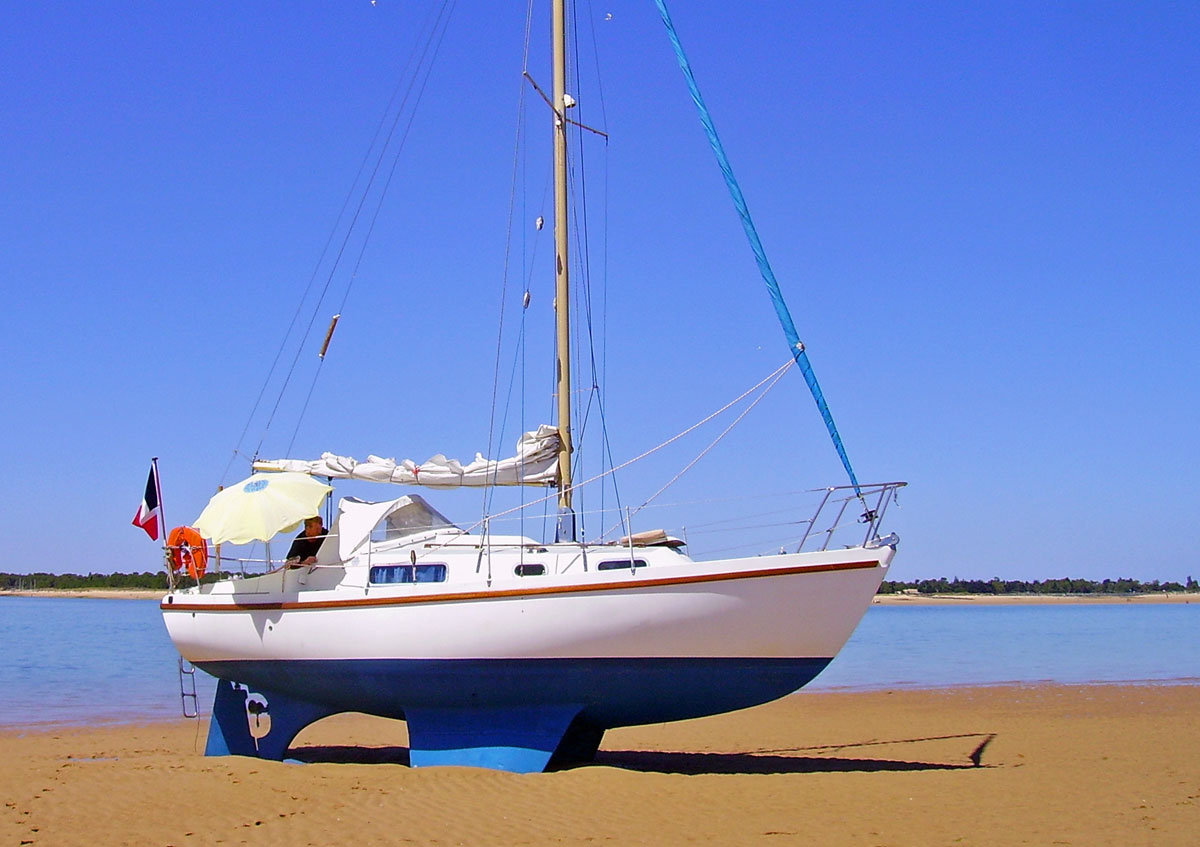
Other popular rigs for cruising offshore...
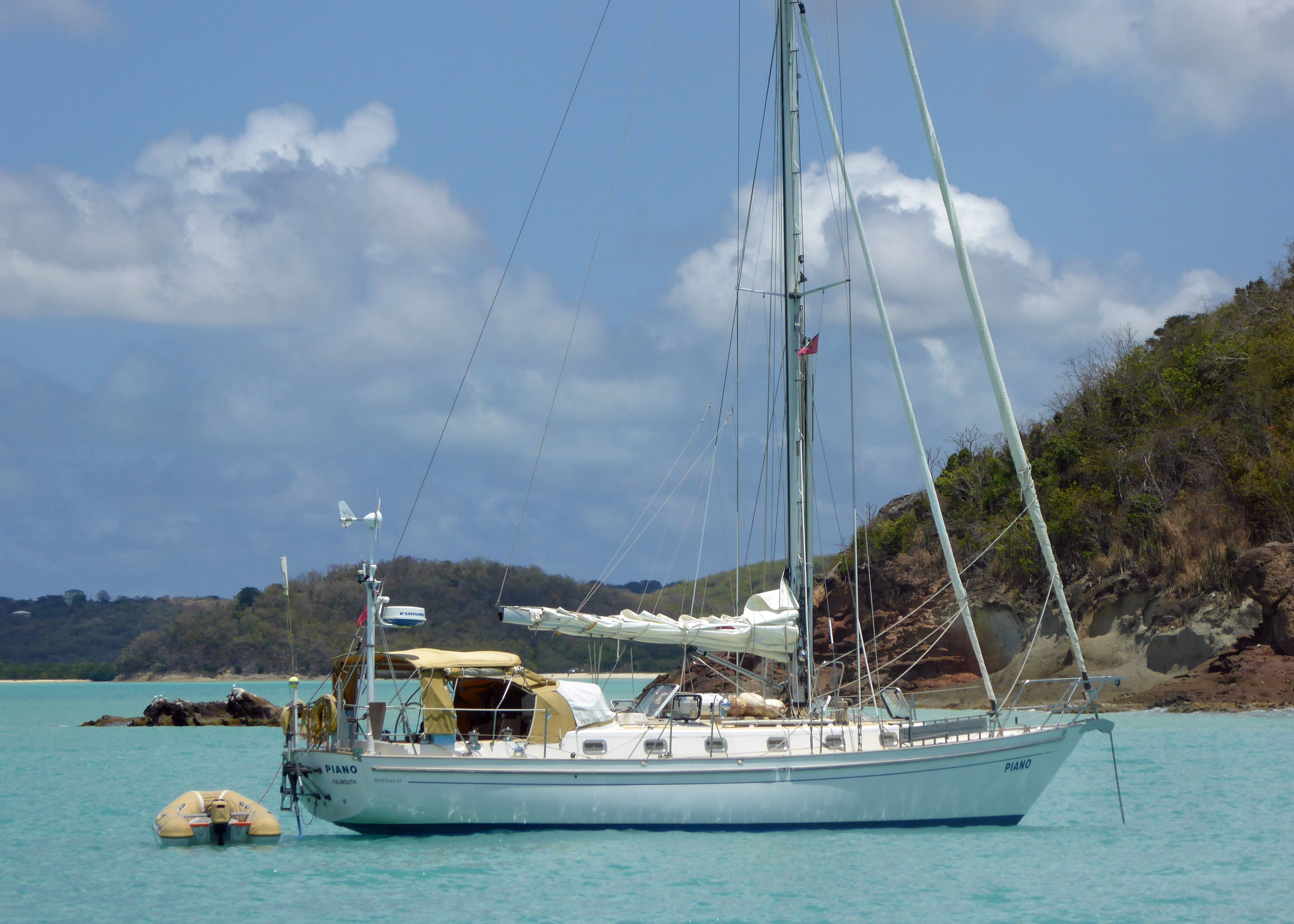
Is the Cutter Rig Superior to the Solent Rig for Offshore Cruising?
Both the cutter rig and the solent rig provide the offshore skipper with a choice of foresails to fly, but there the similarity ends. So what's the difference between these two rigs?
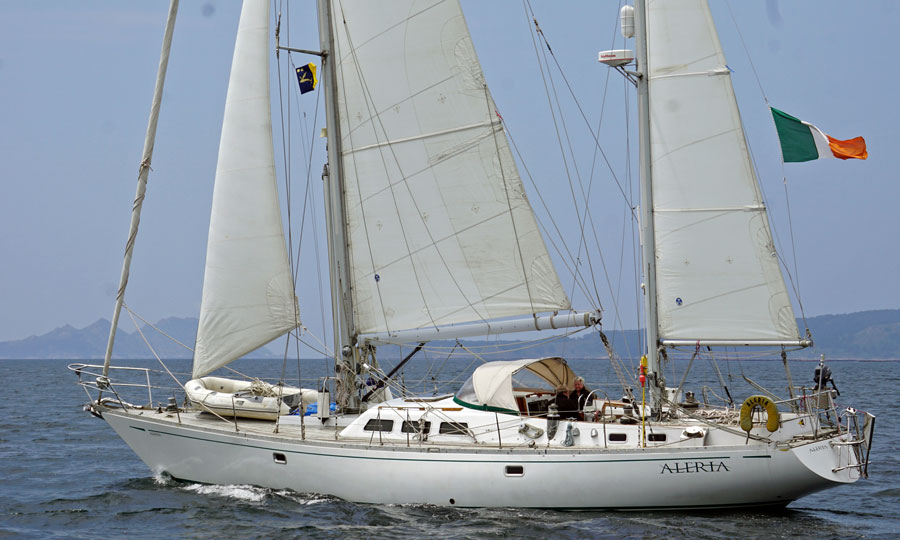
Is The Ketch Sailboat the Best Type of Sailboat for Offshore Cruising?
It's true that the ketch sailboat with its split rig can make an attractive cruising sailboat for a short-handed crew, but there is a downside to these types of sailboats
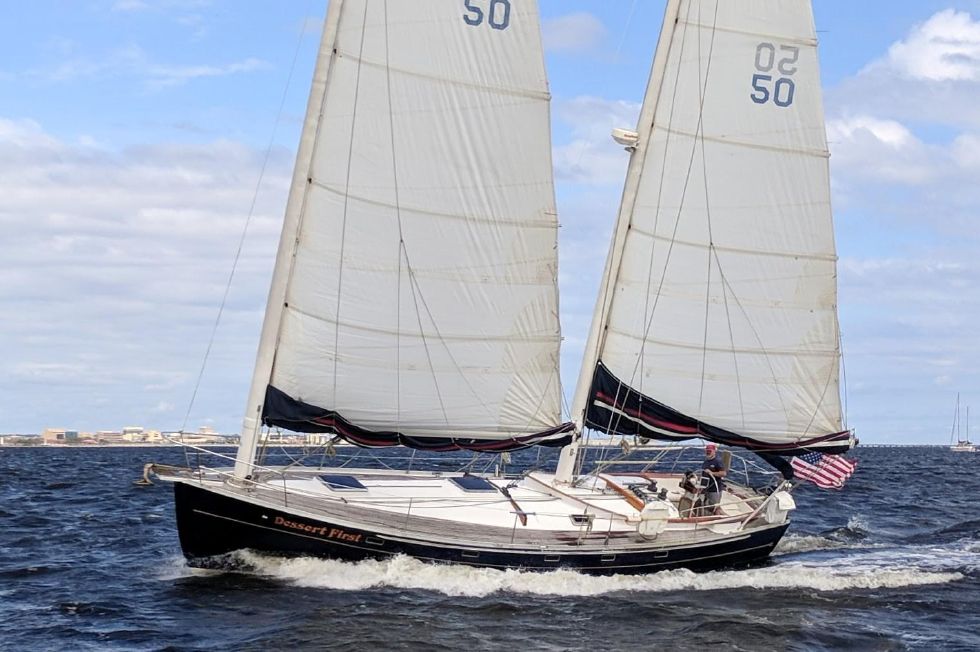
What Are Cat Ketch Sailboats and Do they Make Good Cruising Boats?
Seen alongside the complexity of a conventional sailboat, it's easy to imagine that the unstayed rigs of cat ketch sailboats represent the future for cruising sailboat designs.
Recent Articles
Island Packet 37 Specs
Aug 23, 24 03:17 PM
Jeanneau Sun Odyssey 40 Specs
Aug 23, 24 04:18 AM
Jeanneau Sun Odyssey 409 Specs
Aug 22, 24 11:02 AM
Here's where to:
- Find Used Sailboats for Sale...
- Find Used Sailing Gear for Sale...
- List your Sailboat for Sale...
- List your Used Sailing Gear...
Our eBooks...

Cruising Boats...
Our ever-growing gallery of pics and basic specifications of many popular cruising boats...
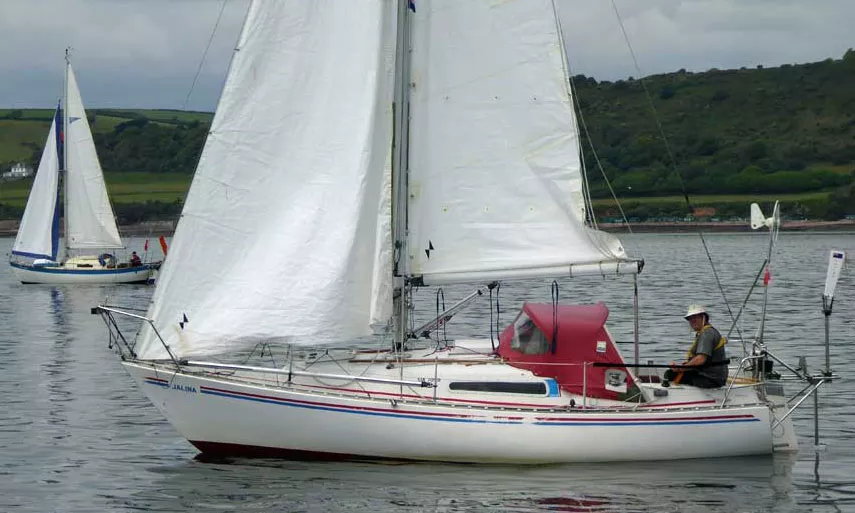
A few of our Most Popular Pages...

Copyright © 2024 Dick McClary Sailboat-Cruising.com

- BOAT SHOWS , Cannes Yachting Festival , Engines , MOTOR BOATS , News , Premieres , SAILBOATS
AMEL 50: A REVOLUTIONARY SLOOP-RIGGED SAILBOAT
- August 30, 2017

Amel Yachts is used to launch new models only occasionally. The Super Maramu range, for example, was produced from 1988 until 2006, establishing itself as the symbol of the “ globetrotting boat” par excellence. If we also consider that the last Amel sloop-rigged cruising yacht was the Santorin in 1989, then it is clear that this brand-new Amel 50 represents a real revolution for the French yacht builder.

Consequently, the new Amel 50 seems to have been designed not only for the high seas and, for the first time, the shipyard has adopted less streamlined lines and a straight powerful bow alongside a midship beam which extends to the rear for better performance and great dimensional stability . As a natural result of the project, the stern houses two rudder blades , something completely new for Amel Yachts, that ensure greater manoeuvrability under sail.

Interiors, too, offer a further confirmation of Amel Yachts ‘s intention of penetrating new markets. On this yacht, space is proportionally the largest never seen on an Amel creation.
That’s probably for all these reasons that the new Amel 50 , although not officially presented yet, has already been nominated for the “ European yacht of the year ” in the “luxury cruiser” category.
The Amel 50 will be officially presented at the Cannes Yachting Festival next September. On that occasion, we will have the opportunity to enjoy a first sea trial and see if the French yacht builder has actually succeed in manufacturing a different boat without compromising the typical and unmistakable Amel spirit that has always made us love its beautiful creations.

https://www.facebook.com/tuttobarche/videos/1648544251831262/
Amel 50 – Technical Specifications
| Hull Length | 15.51 m |
| LOA | 14.51 m |
| Max Beam | 4.79 m |
| Width at waterline | 4.06 m |
| Draft | 2.15 m |
| Ballast | 5,36 t |
| Diesel engine power | 110 hp |
| Weight unloaded | 18.75 t |
| Displacement at full load | 2.,2 t |
| Fresh Water Tank Capacity | 600 l |
| Fuel Tank Capacity | 675 l |
| Mainsail | 62 m² |
| Genoa | 64 m² |
| Staysail (option) | 24 m² |
One Response
How is the boom traveler adjusted?
Leave a Reply Cancel reply
Your email address will not be published. Required fields are marked *
Save my name, email, and website in this browser for the next time I comment.
Language switcher
Browse categories.

You might be interested in
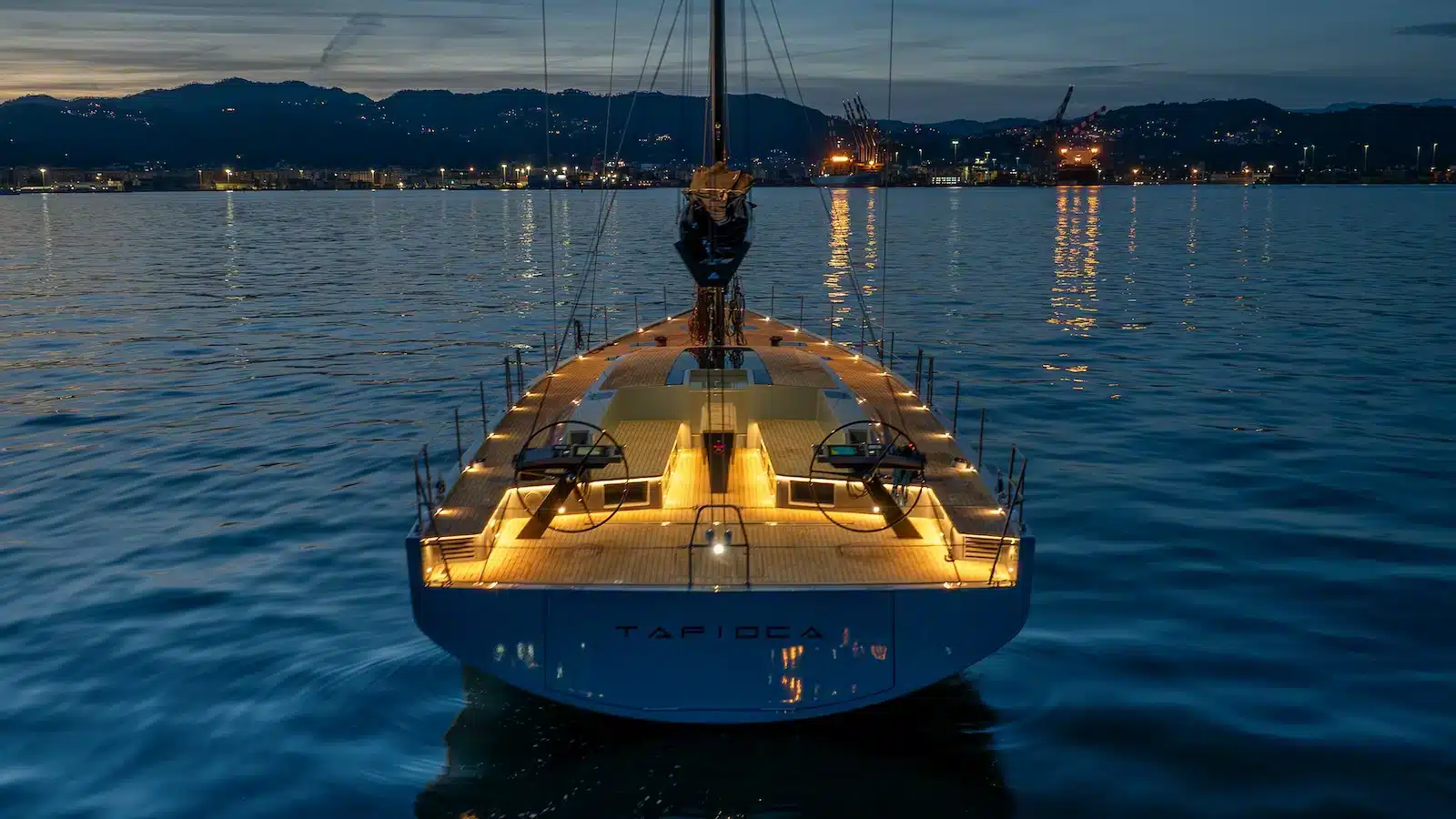
ICE YACHTS: at the Cannes Yachting Festival with two out-of-the-ordinary sailing yachts
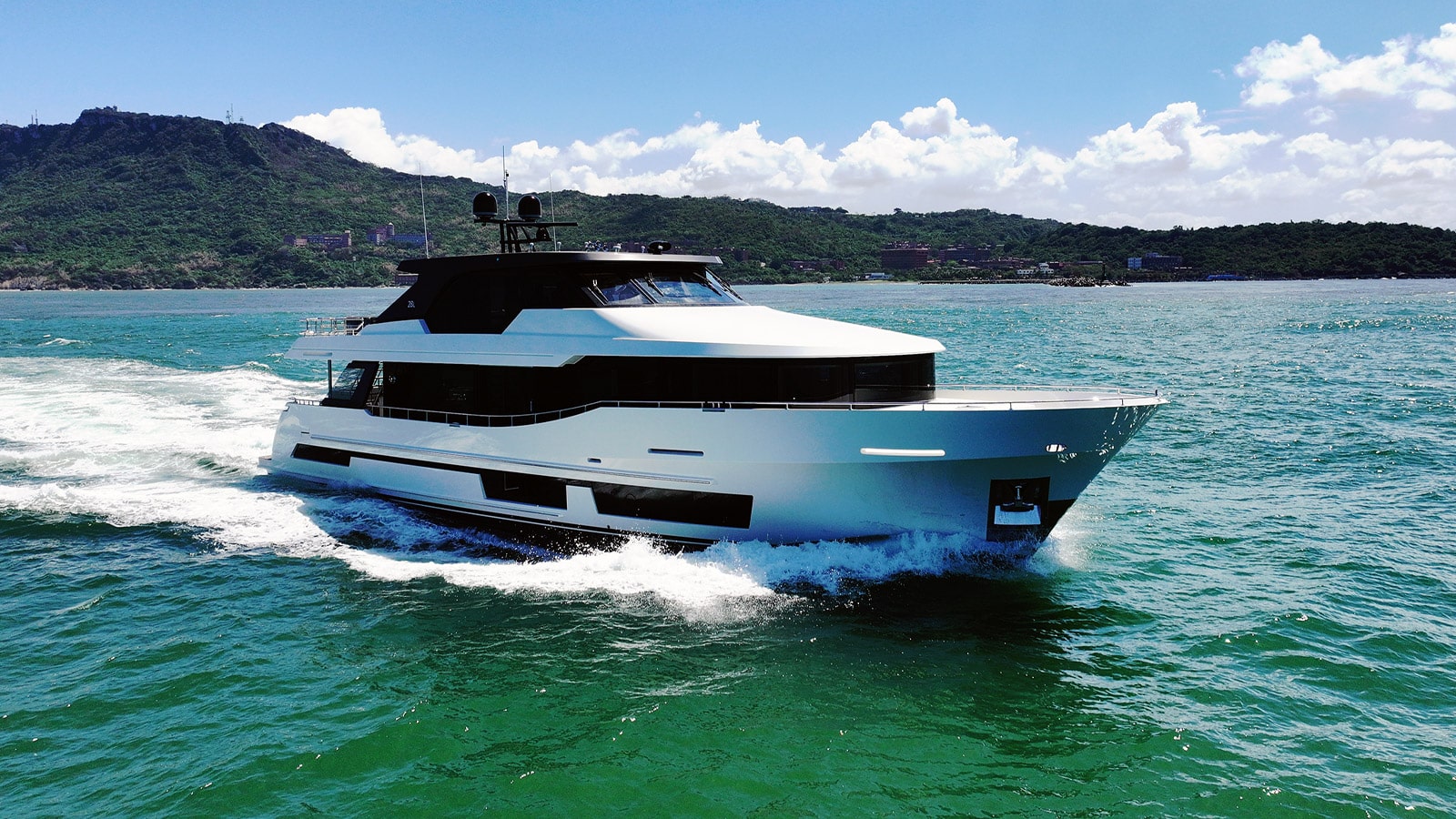
Ocean Alexander 28L, the latest addition to the Legend series
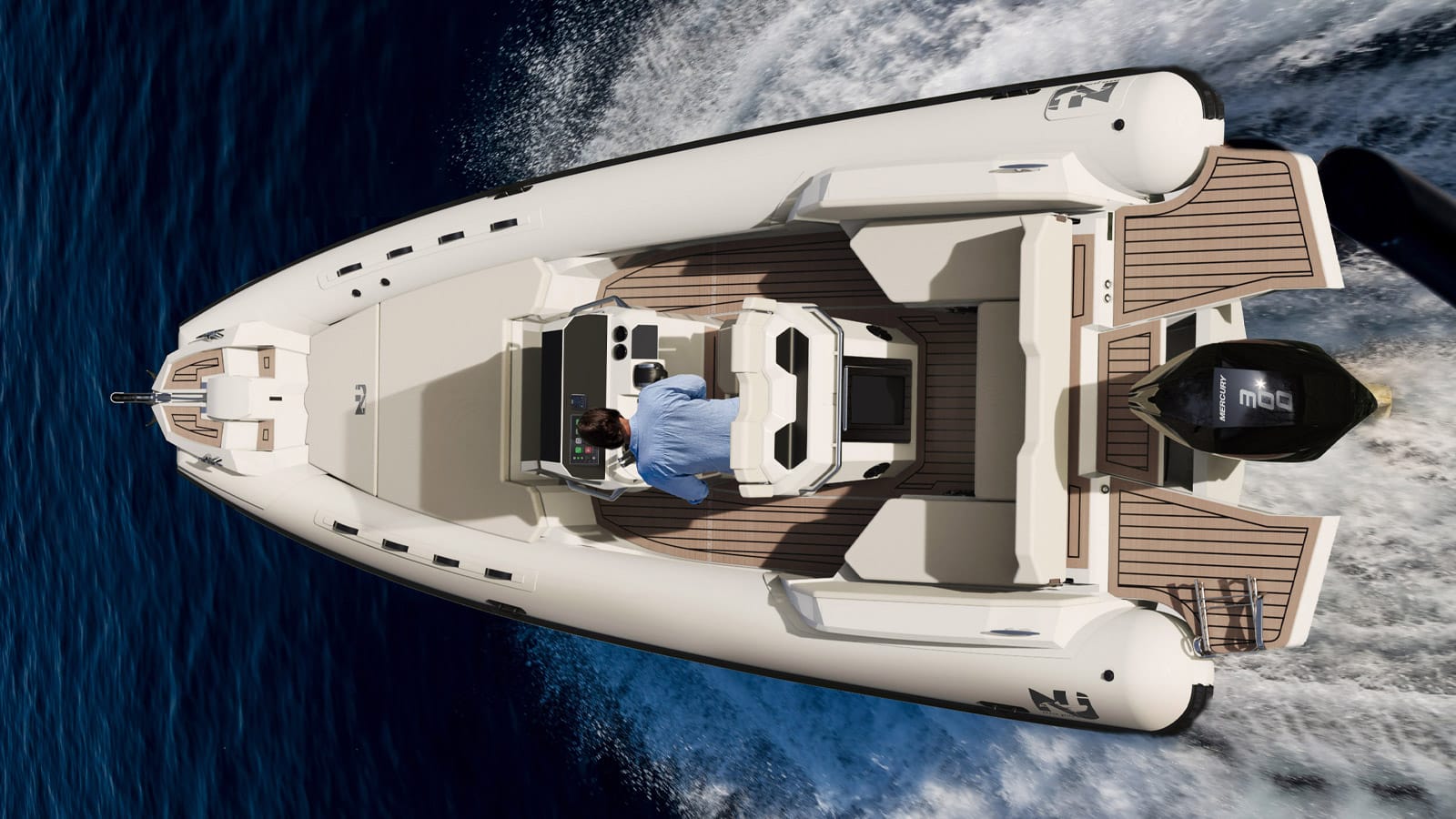
Nuova Jolly in Genoa with 2 world premieres and 6 RIBs on display

Ponza Boat Ticket: details and rates

© 2021 – THE INTERNATIONAL YACHTING MEDIA Designed by BLive Communication
ABOUT YACHTINGNEWS.COM
Yachting News is an interactive multimedia magazine dedicated to the world of boating.
The International Yachting Media is the worlds most widely read boating magazines network. Whit its portal It broadcast its original contents in five languages and in more than 200 countries developing 950,000 views a week. Our web portals are the main source of information for yacht and boat owners, the place where they can find anything about their boating passion.
THEINTERNATIONALYACHTINGMEDIA.COM | SUPERYACHTS.NEWS | YACHT DIGEST
VIRTUAL BOAT SHOW | TUTTTOBARCHE | TOUSLESBATEAUX | TODOSLOSBARCOS
BOATING NEWS FREE APP

To provide the best experiences, we and our partners use technologies like cookies to store and/or access device information. Consenting to these technologies will allow us and our partners to process personal data such as browsing behavior or unique IDs on this site and show (non-) personalized ads. Not consenting or withdrawing consent, may adversely affect certain features and functions.
Click below to consent to the above or make granular choices. Your choices will be applied to this site only. You can change your settings at any time, including withdrawing your consent, by using the toggles on the Cookie Policy, or by clicking on the manage consent button at the bottom of the screen.
Subscribe For Latest Updates
Sign up to receive the best of Yachting News, sea trials, boat review and world premieres .
The only ADVERTISING FREE newsletter
- Ordered by Shipyards & Yacht Brands
- Ordered by Date
- Yacht Designers
- About and Contact
- Yacht Support Vessels
- Tenders & Toys
- Some interesting other sites in the superyacht world
130' Classic Sloop // Reichel/Pugh
The san diego-based yacht design studio reichel/pugh created a new sloop in a classic dress..
Reichel/Pugh presents their design number 301 – a 130-foot (40.87m) classic designed sloop-rigged sailing yacht. The boat has a beam of 8.42m and a fixed draft of 4.20m. The owner’s cabin is in the aft and features a private cockpit to enjoy sailing cruises while the crew works forward/midships.
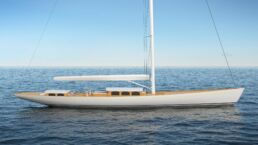
SHARING IS CARING - THANK YOU!
Emma // super fast baltic 80 custom, longitudinalis // julien cadro, mm725 – 72.5m sloop by malcom mckeon yacht design, acadia – truly classic 90 by claasen shipyards, performance classic 83 (pc83) – a modern classic sailing yacht, 55m salt by lujac desautel – crystalline lounge on sea, mm38 // malcolm mckeon yacht design, jongert 3200p.
About Publisher

Using a minimum of third party cookies for YouTube, Vimeo and Analytics.
Privacy Preference Center
Privacy preferences.
Google Analytics

The global authority in superyachting
- NEWSLETTERS
- Yachts Home
- The Superyacht Directory
- Yacht Reports
- Brokerage News
- The largest yachts in the world
- The Register
- Yacht Advice
- Yacht Design
- 12m to 24m yachts
- Monaco Yacht Show
- Builder Directory
- Designer Directory
- Interior Design Directory
- Naval Architect Directory
- Yachts for sale home
- Motor yachts
- Sailing yachts
- Explorer yachts
- Classic yachts
- Sale Broker Directory
- Charter Home
- Yachts for Charter
- Charter Destinations
- Charter Broker Directory
- Destinations Home
- Mediterranean
- South Pacific
- Rest of the World
- Boat Life Home
- Owners' Experiences
- Conservation and Philanthropy
- Interiors Suppliers
- Owners' Club
- Captains' Club
- BOAT Showcase
- Boat Presents
- Events Home
- World Superyacht Awards
- Superyacht Design Festival
- Design and Innovation Awards
- Young Designer of the Year Award
- Artistry and Craft Awards
- Explorer Yachts Summit
- Ocean Talks
- The Ocean Awards
- BOAT Connect
- Between the bays
- Golf Invitational
- BOATPro Home
- Superyacht Insight
- Global Order Book
- Premium Content
- Product Features
- Testimonials
- Pricing Plan
- Tenders & Equipment
.jpg/r%5Bwidth%5D=320/c01b08f0-3198-11ec-b3da-5dc06521023f-Black%20Pearl%20-%20Tom%20Van%20Oossanen%20(3).webp)
The definitive guide to sailing yacht rigging
Related articles, superyacht directory.
Do you know your Bermudan rig from your DynaRig or wingsails? And which is best? BOAT explains it all...
Take a look at a modern racing yacht from above, beating to windward and heeled to the breeze, and you can see at a glance why Bermudan rigs have stood the test of time. With its fore and aft sails bladed into efficient aerodynamic shapes, a modern yacht can slice close to the wind and be driven hard. Such a sight would have been outlandish a century ago. Then, a typical trading barquentine could set 18 sails to catch light airs, but it needed a large crew to battle with canvas far out on the yards. In a modern miracle as incredible in its way as flight, today’s racing yachts can sail faster than the speed of the wind – in some cases several times faster.
A mainsail set on a single spar is an age-old concept but only in the 19th century was it adapted as the Bermudan or Marconi rig. A one-piece mainsail set on a mast without a gaff, hoisted with one halyard and controlled by one sheet, was simpler and more efficient. This revolution became the power train of pleasure yachting and racing.
But perhaps the time is coming for a re-evaluation of simpler rigs requiring fewer crew – alternatives with lower loads operated by automated systems. In an era of reduced carbon consumption, could more radical sailplans even herald a revival in sail power?
The evergreen Bermudan rig
The Bermudan rig is the all-rounder, able to perform well at all angles of sail. It is efficient upwind, while downwind the sail area can be significantly boosted with a big gennaker or spinnaker. For good reasons, it is the first choice for nearly every modern sailing yacht up to around 60 to 65 metres for cruising and regatta racing alike. At larger sizes, however, things start to become trickier, and the trade-offs get interesting.
Over the last decade, sail handling technology has steadily advanced to allow sloop rigs to grow larger and larger. “But with that comes a highly loaded rig, many tonnes of compression from tension in the rigging, and you have to build structure in the boat to accept that,” explains Paul MacDonald, founder and superyacht sales manager of Southern Spars.
“You have to have a lot of deck gear and captive winches below decks and the machinery for that. But over the years, boom furling systems and MPS [Multi Purpose Sails for downwind angles] stored on a drum, for example, have made sail handling safer.
Bill Tripp is the designer behind the 86-metre Aquijo , which broke new ground in 2015 as the world’s largest Bermudan ketch. Tripp prefers to call the rig a "sketch", a portmanteau word for a rig that is neither a sloop nor a ketch “because the main and mizzen are identical”. Even though the sailplan is divided over two masts, each spar is still a towering 90 metres above the water. Aquijo perfectly illustrates the issues involved with a Bermudan rig when scaled up.
“The sloop is great but I prefer the ‘sketch’ for sailing around the world under full control due to the desirability of a two-masted rig for reaching ability, which dominates passages, and the safety of controllable loads when sailing in all kinds of conditions miles from nowhere,” he says.
Upwind, Aquijo sets a jib, staysail, mainsail and mizzen, all in North Sails 3Di, totalling 3,821 square metres. A furling Code sail for reaching and downwind angles increases that to a vast 5,051 square metres.
While Aquijo has a crew retinue of 17, it can be controlled under sail by six or seven people. With custom winches to handle halyards and sheets, the sails can be hoisted astonishingly quickly for such a large rig. “It takes five minutes to put the main up, on average, and the main and mizzen can go up at the same time,” Tripp says. Aquijo has now sailed 100,000 nautical miles around the world and the owner is planning another circumnavigation through the Northwest Passage.
Tripp is not convinced of the wisdom of a much larger single-masted sloop rig. “If you are day sailing in the Med, a sloop would be awesome, but I am not sure if you had fewer sails you would be able to [reduce canvas] well enough. Also the mast is a windage problem when the keel is up and you are beam-to. If you are on anchor, that’s no problem but you’d have to be able to cope with being on the docks in 70 knots. The windage at 120 metres is not only more but the centre of effort is so much higher, and so the heeling loads all go up.”
However, British designer Malcolm McKeon , the name behind the high-performance, sloop-rigged carbon composite superyachts Missy and Ribelle , is pushing the sloop rig to new heights. His 85-metre design concept Apex, developed with Royal Huisman , would be the largest sloop-rigged yacht in the world. “The loads are enormous,” he admits, “but it is all scalable.”
“The big disadvantage is sail handling. The downwind sails are pretty complicated once you start hoisting and retrieving, even with drum and reel systems. It is not straightforward.” But, he adds, “I think we know the advantages of a sloop: if you want all-round performance you can’t beat it, even at the top end.”
Advantages of a clipper rig
The DynaRig has been around as a concept since the 1960s when German engineer Wilhelm Prölss devised these free-standing, rotating rigs as a fuel-saving solution for large commercial vessels. The idea was ahead of its time, so much so that its first realisation came nearly 40 years later when American owner Tom Perkins bought the residual technology and commissioned Dykstra Naval Architects to create a three-masted DynaRig for Maltese Falcon , his 88-metre Perini Navi.
The DynaRig is not as efficient upwind as the Bermudan rig, and is probably not the best solution for a yacht smaller than around 65 metres, suggests Jeroen de Vos of Dykstra. “We wouldn’t advise putting a DynaRig on a small yacht because there are other ways to manage sail handling. But on a larger yacht the DynaRig becomes an alternative because there is no rigging, no highly loaded sheets, low-tech [small] sails and no big winches.”
The beauty of the DynaRig is that its automatic systems can be handled by one or two people and, notes de Vos, “you don’t have to get out of your chair to go sailing. Maltese Falcon can sail on and off the anchor and can set 2,400 square metres of sail in six minutes. On other boats it takes six minutes to get the sail cover off.”
Damon Roberts of Magma Structures, which built the rigs for Maltese Falcon and the only other DynaRig yacht to date, the 106-metre Black Pearl , says: “You can do any manoeuvre easily; it’s like sailing a dinghy. There are no highly loaded sheets or ropes or flogging lines. You can luff up, bear away, tack and gybe at any time and really enjoy sailing the boat without any apparent fuss.”
So with all these advantages, why has the DynaRig been chosen for only two sailing superyachts? For some designers, such as Malcolm McKeon, it is partly to do with compromises imposed by the large mast tubes and bearing diameters on the internal structure and layout, “particularly in the cockpit area,” he says. He also points out that the clipper ship look is not to every owner’s taste. “Sloops are more conventional looking,” he says.
Damon Roberts says there is still development work to be done. He has teamed up with Southern Spars and, with their additional resources, expects evolution with several new projects. “These include two at the moment that are twin-masted DynaRigs,” he says. “We did quite a lot of wind tunnel work early on as we felt that was really the sweet spot for it, and people will be stunned at how efficient these are.”
The future of the wingsail
Wingsails have been around for decades too, but with their adoption by the last two America’s Cups and the confluence with foiling technology, they have undergone rapid and revolutionary development.
To date, there is no proven solution for reefing a wing that would be suitable for offshore cruising or ocean passages. As the pronounced aerodynamic “nose” at the leading edge of a wing can develop force in strong winds, they could potentially make a large yacht uncontrollable in port as well.
“How do you get rid of sail and how does [a boat] handle when caught out in heavy wind conditions – which you will be? How do you keep the angle of attack all the way up the rig and how do you handle squalls?” Roberts asks. “A mechanism to reduce sail might be easy to sketch out but it is difficult to engineer.”
Jeroen de Vos says: “The wingsails are more developed towards performance and I wouldn’t say that they are as practical as soft sails or would ever make handling easier. But if somebody wants that, why not? Reefable soft sails, wings that are inflated, hoisted panels, possibly these are applicable. The development of this area is happening very rapidly.”
Paul MacDonald of Southern Spars agrees that the time is not here yet but thinks it will come. “In reality we are in the early days of wings. For the America’s Cup, they are the most efficient way of sailing by a long shot, but with them comes handling issues, which the industry hasn’t resolved yet. But I am sure they will be in 10 years’ time. Designers such as VPLP are starting to [work on concepts] and we are going to see something that is usable and efficient and suitable for ocean work eventually,” he says. “And whatever the solution is, you imagine that it will scale.”
Looking to the future
A drive for greener superyachts could present an opportunity for sail, but perhaps it needs to be less daunting.
“There is this intimidation of sheets and backstays, and sailing is a language you don’t learn in a year,” Tripp says. “But we have a project we are doing now with a yard with some new rig technology and some soft wings that we think is going to be viable.
“We can uncomplicate sailing more. If we can win people over from motorboats it will help, but we are only winning these battles one or two at a time. We need [more] projects like Sailing Yacht A , which are something really different, and do more things better with less energy. We as architects need to elicit change.”
McKeon also sees change coming. “People are more and more concerned about keeping their image green and sails are the way to do that,” he says. “Simpler sailing systems are needed. The current generation is used to Bermudan sloops. In years to come, the traditionalists will all be gone, and maybe new people will be more accepting of [different ideas]. I think in the future we will certainly have wings.”
Sign up to BOAT Briefing email
Latest news, brokerage headlines and yacht exclusives, every weekday
By signing up for BOAT newsletters, you agree to our Terms of Use and our Privacy Policy .
More about this yacht
Yachts for sale, similar yachts for sale, yachts for charter, more stories, most popular, from our partners, sponsored listings.

Sailboat Sloop: The Ultimate How To
Introduction:.
The sailboat sloop is a popular type of watercraft designed to cater to the needs of sailing enthusiasts and adventurers seeking thrilling journeys on the open water. These boats offer a balanced combination of performance, ease of handling, and comfortable accommodations. In this comprehensive comparison, we will delve into the key characteristics of sailboat sloops, including their design, features, rigging options, and discuss the top brands in the market.
Sailboat Sloop Design and Purpose:
Sailboat sloops are meticulously designed to provide a versatile sailing experience. They typically feature a single mast and a sloop rig configuration consisting of a mainsail and a headsail, such as a genoa or jib. The hull design of sailboat sloops prioritizes stability, speed, and maneuverability, allowing sailors to navigate various sailing conditions with confidence. With their moderate displacement and keel or centerboard, sailboat sloops excel in coastal cruising as well as longer voyages.
Sailboat Sloop Key Features:
Sailboat sloops have comfortable accommodations for extended stays on the water. It includes spacious cabins, a well-equipped galley, and a salon area for dining and relaxation. The interiors are designed to maximize living space and provide essential amenities for a comfortable sailing experience.
- Efficient Sail Handling Systems: Sailboat sloops feature efficient sail-handling systems that make it easy to adjust sails for optimal performance. These systems often include roller furling headsails and in-mast or in-boom furling mainsails, allowing sailors to quickly and effortlessly adapt to changing wind conditions. The incorporation of winches and control lines further enhances the ease of sail handling.
- Stability and Performance: Sailboat sloops prioritize stability and performance to deliver an exhilarating sailing experience. Their hull designs and keel configurations provide stability and reduce excessive rolling in rough seas. Sailboat sloops are known for their balanced performance, combining speed and maneuverability without compromising on comfort, allowing sailors to enjoy both leisurely cruising and spirited sailing.
The Sloop Rig:
The sloop rig consists of a single mast and two sails—a mainsail and a headsail (genoa or jib). This rig allows for easy handling and adaptability in various wind conditions, making it suitable for a wide range of sailing styles, from leisurely coastal cruising to more challenging offshore passages.
Appropriate Buyers and Considerations:
Sailboat sloops are ideal for sailing enthusiasts who appreciate a balanced combination of performance and comfort. When considering a sailboat sloop, potential buyers should take the following factors into account:
- Sailing Preferences: Determine your preferred style of sailing, whether it’s coastal cruising, day sailing, or longer voyages. This will help you choose a sailboat sloop that aligns with your intended use and sailing goals.
- Accommodation Needs: Consider the number of people you plan to accommodate on board and ensure the boat provides sufficient sleeping quarters and living space. Evaluate the functional galley, marine head, and storage capacity.
- Budget: Sailboat sloops vary in price depending on factors such as size, brand, features, and rigging options. Establishing a budget and researching different models within your price range will help you find the best sailboat sloop.
Sailboat Sloop Top Brands:
When searching for a sailboat sloop, it’s essential to explore reputable brands known for their quality construction, sailing performance, and cruising-specific features. Here are three top sailboat sloop brands worth considering:
- Beneteau is a renowned sailboat sloop brand that has earned a stellar reputation for its extensive range of sailboats designed for cruising and racing. Known for their exceptional performance, innovative design, and superior craftsmanship, Beneteau sailboats are favored by sailors worldwide.
- Beneteau sailboats are meticulously engineered to deliver optimal sailing performance. Their sloop designs incorporate advanced hull shapes, efficient sail plans, and cutting-edge rigging systems, allowing for excellent speed and maneuverability on the water. Whether you’re navigating coastal waters or embarking on offshore adventures, Beneteau sailboats offer a perfect balance of performance and comfort.
- The interiors of Beneteau sailboats are carefully designed to maximize space and functionality. With a focus on ergonomic layouts and high-quality materials, these sailboats provide comfortable accommodations for extended stays. Beneteau offers a variety of cabin configurations, ensuring that sailors have ample room for sleeping, dining, and relaxing onboard.
- Beneteau sailboats cater to a diverse range of sailing preferences and needs. From compact cruisers to luxurious yachts, the brand offers models suited for different cruising styles and requirements. Whether you’re a seasoned sailor or a novice looking to embark on your first sailing adventure, Beneteau sailboats provide the performance, comfort, and versatility to meet your expectations.

- Jeanneau is a prestigious sailboat sloop brand that has become synonymous with elegance, performance, and cruising comfort. With a strong emphasis on innovative design, quality construction, and attention to detail, Jeanneau sailboats are highly regarded by sailing enthusiasts around the globe.
- Jeanneau sailboats are designed to deliver exceptional sailing performance. Their sloop configurations feature sleek hulls, efficient sail plans, and advanced rigging systems, enabling sailors to enjoy exhilarating experiences on the water. These sailboats are known for their stability, responsiveness, and ease of handling, making them ideal for both short trips and long-distance cruising.
- The interiors of Jeanneau sailboats exude sophistication and comfort. Crafted with meticulous care, the cabins offer spacious living areas, ergonomic layouts, and high-quality finishes. Jeanneau prioritizes creating inviting and functional spaces, ensuring that sailors have a cozy retreat to relax and unwind after a day of sailing.
- Jeanneau sailboats encompass a wide range of models, accommodating different sailing preferences and needs. From compact cruisers to luxurious yachts, the brand offers options for sailors of all levels of experience. With their focus on performance, comfort, and stylish design, Jeanneau sailboats continue to impress and inspire sailors worldwide.

Hylas Yachts:
- Hylas Yachts is a renowned sailboat sloop brand known for its exceptional craftsmanship, luxurious interiors, and outstanding sailing performance. They are meticulously built with attention to detail, incorporating high-quality materials and innovative design elements.
- Sailors appreciate Hylas Yachts for their seaworthiness and excellent performance under sail. These sailboat sloops feature advanced rigging systems, efficient sail handling, and well-balanced hull designs. Hylas Yachts are designed to offer a perfect balance of speed, stability, and comfort, making them a preferred choice for long-distance cruising and offshore passages.
- The interiors of Hylas Yachts are crafted with elegance and functionality in mind. The cabins are spacious, featuring luxurious accommodations and ample storage space. Hylas Yachts are known for their attention to detail in the craftsmanship of their interiors, providing a comfortable and inviting environment for extended stays on board.
- Hylas Yachts offer a range of models to cater to different sailing preferences and requirements. Whether you’re seeking a compact sloop for coastal cruising or a larger yacht for extended offshore adventures, Hylas Yachts provides options to suit various needs. Their commitment to quality, performance, and luxury has solidified Hylas Yachts as one of the top brands in the market.
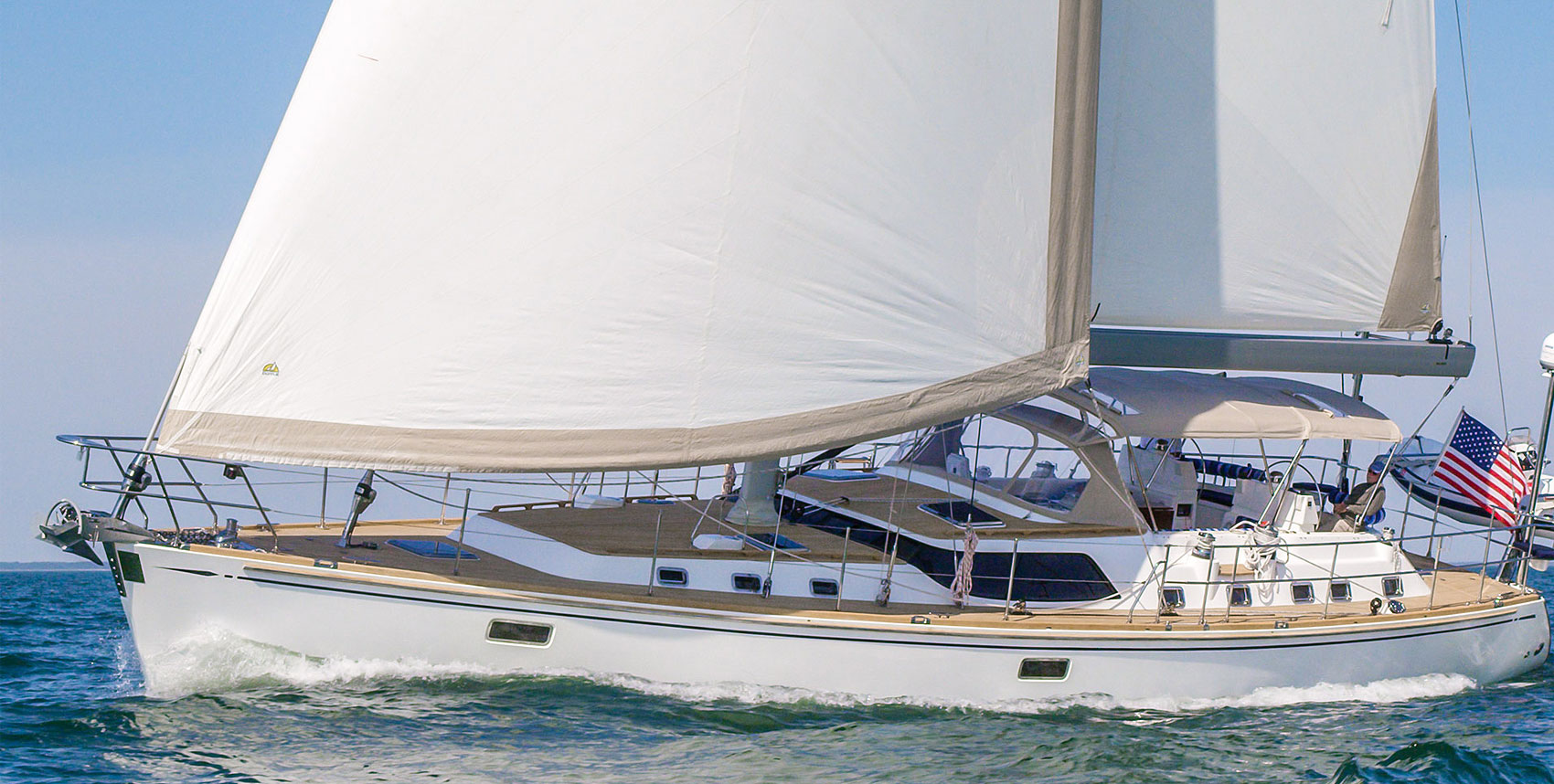
Conclusion:
Sailboat sloops provide sailing enthusiasts with a versatile and thrilling experience, combining performance, ease of handling, and comfortable accommodations. When considering a sailboat sloop, it’s important to evaluate the design, key features, rigging options, and accommodation needs to find a boat that suits your specific sailing requirements. Exploring reputable brands such as Beneteau, Jeanneau, and Hanse will assist you in making an informed decision and selecting a sailboat sloop that delivers both performance and comfort on the water.
We encourage you to use Rabbet to connect with the rest of the boating community! Hop onto our Learn tab to find more articles like this. Join our various forums to discuss with boating enthusiasts like you. Create an account to get started.
Visit us on Pinterest to collect content and inspire others.
Previous Post Wooden Boats: The Ultimate Poetry
Next post boat hull materials: everything you need to know, related posts.
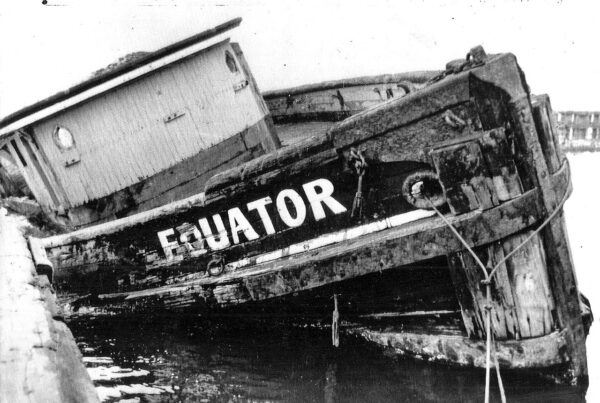
Downsizing and Living Aboard for Retirees and Empty Nesters

- Find A School
- Certifications
- North U Sail Trim
- Inside Sailing with Peter Isler
- Docking Made Easy
- Study Quizzes
- Bite-sized Lessons
- Fun Quizzes
- Sailing Challenge

Miami Sailing School stands out as the premier destination for sailing education and adventure in the vibrant city of Miami, offering an unparalleled experience on the shores of Biscayne Bay. Nestled in the historic neighborhood of Coconut Grove, our school benefits from ideal sailing conditions, including steady winds and clear waters, creating the perfect environment for mastering the art of sailing. Whether you’re a novice or an experienced sailor, you’ll experience the thrill of sailing on Biscayne Bay, with its lively and dynamic waters offering an exhilarating mix of conditions. After your time on the water, you can enjoy the vibrant waterfront neighborhood of Coconut Grove, known for its welcoming community and rich sailing tradition.
What sets our school apart is our unwavering commitment to personalized instruction and exceptional customer experiences for individuals, couples, and small groups of up to four persons. Unlike other schools, we prioritize individualized attention, ensuring that each student receives tailored guidance to meet their specific learning needs and goals. Our instructors, seasoned professionals with a wealth of knowledge and years of experience both on the water and in teaching, create a supportive and enriching learning atmosphere for students of all levels.
At Miami Sailing School, we offer comprehensive and hands-on sailing classes on a 40 ft. luxury yacht and a 40 ft. Catamaran. Our classes run for up to 8 hours per day, with as much as 6 hours of onboard sailing each day, providing students with the best opportunity to achieve their goals and gain valuable hands-on experience. Our curriculum is designed to not only impart sailing skills but also prioritize safety measures and uphold the highest quality standards, ensuring a secure and enriching learning environment for all our students.
In conclusion, Miami Sailing School, located in the picturesque neighborhood of Coconut Grove, Miami, stands out for its unparalleled sailing conditions, personalized instruction, and experienced instructors. Our school is the ideal choice for anyone seeking a comprehensive and rewarding sailing education experience on the beautiful Biscayne Bay.
American Sailing Certifications Offered

Other Services Available
- Couples Courses
- Private Courses
- Weekday Courses
- Weekend Courses
- Corporate Team Building Courses
- ASA 'Challenges'
- Vacation Charters
- Sunset Cruises
- Sailboat Cruises
Contact Information
| Address | 2950 SW 27th Ave, Ste 100MiamiFL33133 |
|---|---|
| Phone | (305) 333-4414 |
| Website | |
| Social Media | |
| | |
Other Popular Schools...

- Learn To Sail
- Mobile Apps
- Online Courses
- Upcoming Courses
- Sailor Resources
- ASA Log Book
- Bite Sized Lessons
- Knots Made Easy
- Catamaran Challenge
- Sailing Vacations
- Sailing Cruises
- Charter Resources
- International Proficiency Certificate
- Find A Charter
- All Articles
- Sailing Tips
- Sailing Terms
- Destinations
- Environmental
- Initiatives
- Instructor Resources
- Become An Instructor
- Become An ASA School
- Member / Instructor Login
- Affiliate Login
Structured data
Items portrayed in this file.
- Coats of arms of districts of Tomsk Oblast
- Horses in heraldry of Russia
- Horses of Tomsk Oblast
- PD-RU-exempt (coats of arms)
- Coat of arms images that should use vector graphics
- JPG images that should use vector graphics
- Media missing infobox template
- Files with no machine-readable author
- Files with no machine-readable source
Navigation menu

IMAGES
COMMENTS
The sail rig is determined by the number of masts and the layout and shape of sails. Most modern ships are fore-and-aft rigged, while old ships are square-rigged. Rigs with one mast are sloops and cutters. Ketches, yawls, brigs, and schooners have two masts. Barques have three masts. Rigs can contain up to seven masts.
Bayesian was a flybridge sloop designed by Ron Holland and built with a 56 m (184 ft) aluminium hull and a single-masted cutter rig.The 75 m (246 ft) aluminium mast was especially designed for the yacht and at the time of construction was the world's tallest. The yacht had a lifting keel, allowing its draft to be reduced from 10 m to 4 m. [6] It was one of a number of similar vessels from the ...
Gaff rigged sloop, 1899. A sloop is a sailboat with a single mast [1] typically having only one headsail in front of the mast and one mainsail aft of (behind) the mast. [note 1] Such an arrangement is called a fore-and-aft rig, and can be rigged as a Bermuda rig with triangular sails fore and aft, or as a gaff-rig with triangular foresail(s) and a gaff rigged mainsail.
Sloop Rigged Hylas 46. Sloop The simplest and most popular rig today is the sloop. A sloop is defined as a yacht whose mast is somewhere between stations 3 and 4 in the 10 station model of a yacht. This definition places the mast with two thirds of the vessel aft and one third forward. The sloop is dominant on small and medium sized yachts and ...
A Bermuda rigged sloop with a single jib is known as a Bermuda sloop, a Marconi sloop, ... The term Marconi rig was first applied to the tall Bermuda rig used on larger racing yachts, such as the J class used since 1914 for the America's Cup international yacht races, as ...
Short answer: Sloop rigged sailboat A sloop rigged sailboat is a type of sailboat that features a single mast and two sails, namely a mainsail and a headsail. This popular rigging configuration allows for efficient sailing both upwind and downwind, making it widely used in recreational and racing boats. The sloop rig provides versatility and
First up, what many of us sail - the Sloop Rig. A sloop rig is a boat with a single-mast and a fore and aft sail configuration. Sloops date back to the early 17 th century but didn't really become popular until the 20 th century. The likely reason for their popularity is their ability to effectively head up wind and how relatively simple ...
There are a number of actual vessel styles that can use a sloop rig, which features a single, larger central mast for easy handling. ... YachtWorld presently offers a selection of 2,303 sloop yachts for sale. Among them, 328 are newly built vessels available for purchase, while the remaining 1,975 comprise used and custom yachts listed for sale
The gaff-rigged sloop is similar to the Gunter rig in that it uses a gaff rigged mast with an additional spar called the gaff topsail. However, it also features a headsail like the Bermuda rig. ... The 19th century saw the rise of yacht racing, with sloops becoming a popular choice among sailors due to their versatility and ease of handling. In ...
Sloop rigging refers to the configuration of a sailboat 's mast, boom, and sails. In a traditional sloop rig, there is a single mast located at the front of the boat called the mainmast, and it carries one mainsail. The mainsail extends from the top of the mast to the boom, which is attached near its bottom end.
We offer the cutter rig on all our modern offshore cruising yachts from the Rustler 37 (shown) upwards. For a cutter to work efficiently, the base of its foretriangle needs to be a minimum of around 4.25m (14ft). The deck must be strongly reinforced, and it may need some supporting structure beneath it, to take the loads from the inner forestay.
Cruising sailors once upon a time preferred such rigs, at least on larger cruising boats, because each separate sail requiring handling was smaller and thus more manageable. These days, however, by far the most popular rig for both racing and cruising sailboats is the simple sloop rig. This has a single mast supporting a single Marconi mainsail ...
A sloop rig has 1 mast, with a jib and mainsail. A cutter is a sloop with 2 foresails (jib, staysail) and a mainsail. A ketch has 2 masts. It has a foresail,main and missin. It could have a staysail, if it is a cutter ketch. A yawl has 2 masts, one behind the rudder post. The jigger on the 2nd mast is a control sail, not normally used for ...
Low Aspect Ratio - better off the wind. Sailing sloops with moderate rigs though, are probably the most popular of all cruising sailboats. With just a single mast, two sails (a foresail or headsail, and a mainsail) and the minimum of rigging and sail control lines they are relatively simple to operate and less expensive than two-masted ketch rigs.
If we also consider that the last Amel sloop-rigged cruising yacht was the Santorin in 1989, then it is clear that this brand-new Amel 50 represents a real revolution for the French yacht builder. The redesigned hull shape and the new sailing area lines of this model seem to be completely different from the traditional parameters proposed by ...
The San Diego-based yacht design studio Reichel/Pugh created a new sloop in a classic dress. ... Reichel/Pugh presents their design number 301 - a 130-foot (40.87m) classic designed sloop-rigged sailing yacht. The boat has a beam of 8.42m and a fixed draft of 4.20m. The owner's cabin is in the aft and features a private cockpit to enjoy ...
However, British designer Malcolm McKeon, the name behind the high-performance, sloop-rigged carbon composite superyachts Missy and Ribelle, is pushing the sloop rig to new heights. His 85-metre design concept Apex, developed with Royal Huisman, would be the largest sloop-rigged yacht in the world. "The loads are enormous," he admits ...
Sailboat Sloop Design and Purpose: Sailboat sloops are meticulously designed to provide a versatile sailing experience. They typically feature a single mast and a sloop rig configuration consisting of a mainsail and a headsail, such as a genoa or jib. The hull design of sailboat sloops prioritizes stability, speed, and maneuverability, allowing ...
ASA 101, Keelboat Sailing 1 Learn to skipper a 20' - 27' sloop-rigged keelboat by day, in light to moderate winds and sea conditions. Learn basic sailing terminology, parts and functions, helm commands, basic sail trim, points of sail, buoyage, seamanship and safety including basic navigation rules to avoid collisions and hazards.
Rubicon Yachts- San Rafael. 25 Third Street, San Rafael, 94901, United States. View phone number. Name. Email Phone (optional) Contact Broker. ... 1984 Tayana Sloop Rigged Cutter | 36ft. San Rafael, California. US$69,000 . Own this boat for $524/month. Customize. Rubicon Yachts- San Rafael.
146 Likes, TikTok video from Fraser Yachts (@fraser_yachts): "The largest Carbon Composite sloop-rigged sailing yacht in the world, Pink Gin VI 🌊 For sale with Fraser Yachts 🙌#yachting #sailing #sail #yacht #yachts #sailingtiktok #superyacht". Orinoco Flow (Sail Away) [Single Version] - Enya.
Sign in to get trip updates and message other travelers.. Tomsk ; Hotels ; Things to Do ; Restaurants ; Flights ; Vacation Rentals ; Travel Stories
Comment - This license tag is also applicable to official documents, state symbols and signs of the Russian Soviet Federative Socialist Republic and the Union of Soviet Socialist Republics (union level).. Warning - This license tag is not applicable to drafts of official documents, proposed official symbols and signs, which can be copyrighted.. Warning
Restaurants near Tomsk State University, Tomsk on Tripadvisor: Find traveler reviews and candid photos of dining near Tomsk State University in Tomsk, Russia.
Perchini, Tomsk: See 25 unbiased reviews of Perchini, rated 3.5 of 5 on Tripadvisor and ranked #95 of 467 restaurants in Tomsk.